What's a Sailboat With Two Hulls Called? (3 Examples)
A sailboat with two hulls offers several advantages over traditional monohull sailboats, including greater stability, speed, and space. If you want to learn more about the types and key features of two-hulled sailboats, we'll give you three distinct examples and help you decide which one fits your needs.
A sailboat with two parallel hulls is known as a catamaran. The hulls are connected by a deck, which provides a wide and stable platform, allowing them to sail faster and more efficiently than monohulls. Some of the most common catamaran types include cruising catamarans, racing catamarans, and power catamarans.
Aside from a catamaran, there are other types of two-hulled sailboats, such as the proa and the Polynesian double canoe. Let's see how they differ from a catamaran and what their use or purpose is.
- Catamarans are proven safer than traditional sailboats with a single hull, and they are less likely to tip over.
- Catamarans typically have two sails, one on each mast, which are larger and more efficient than those found on traditional sailboats.
- Catamarans have a shallower draft which allows them to access shallow anchorages and navigate in areas where traditional sailboats cannot.
- Power catamarans provide the stability and space of a catamaran with the speed and convenience of a motorboat.
- The proa is a two-hulled sailboat with asymmetric hulls that only sails in one direction and has a minimalist design.
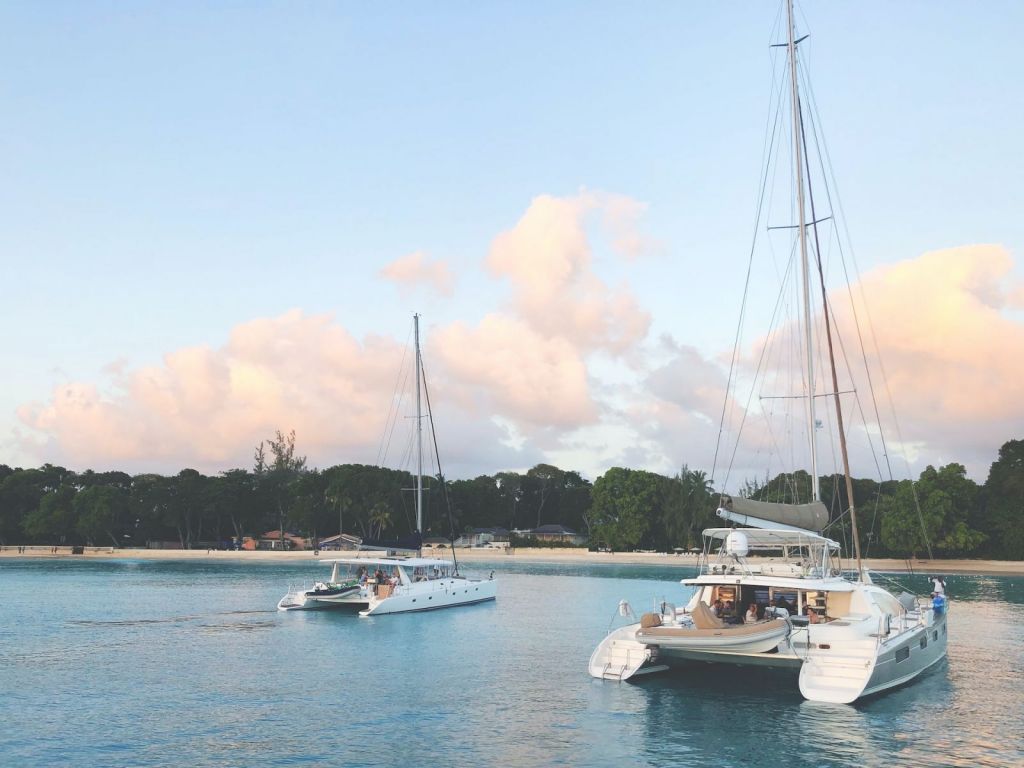

On this page:
The two-hulled sailboat: catamaran, 3 common types of catamarans, other types of two-hulled sailboats.
A sailboat with two hulls is popularly known as a catamaran . Catamarans are a popular choice for sailing enthusiasts due to their stability, speed, and comfort compared to monohulls , especially in rough seas.
The table below summarizes how you can identify a catamaran based on the presence and number of each part:
| Two hulls connected by a deck | |
| Two sails (mainsail and jib), spinnaker (optional) | |
| Two masts, typically near the center of each hull | |
| Two rudders, one on each hull | |
| Two daggerboards, one in each hull | |
| Shallow draft |
They have two hulls
Unlike traditional sailboats that have a single hull, a multihulled boat such as a catamaran is considered to have one of the most stable hull designs . This allows them to sail faster and more efficiently than traditional sailboats. They are also less likely to tip over, making them a safer option for inexperienced sailors.
The two hulls also provide a wider base which reduces the rolling motion that can cause seasickness. Additionally, they allow for more living space on the boat, making them suitable for long-term cruising and living aboard.
If you're curious if a catamaran can still capsize despite having two hulls, here's an article to answer your question.
The hulls can be made of various materials, including fiberglass, aluminum, and wood. Fiberglass is a popular option due to its durability, strength, and ease of maintenance.
Meanwhile, the aluminum's strength and resistance to corrosion can make it ideal for sailing in saltwater environments. Wood is a traditional material used for boat building and can provide a classic look to a catamaran, but it requires more maintenance than other materials and can be more susceptible to rot and damage.
Other materials that can be used for catamaran hulls include carbon fiber, Kevlar, and composites. These materials are lightweight and strong, so they are ideal for racing catamarans that require speed and agility.
They have two sails
Catamarans typically have two sails, one on each mast. The sails can be adjusted to catch the wind and propel the boat forward. They can sail faster than traditional sailboats due to their lightweight design and ability to catch more wind.
The sails are typically larger and more efficient than those found on traditional sailboats. This is because catamarans have a wider beam, which allows for a greater sail area without compromising stability.
The two sails on a catamaran are usually a mainsail and a jib. The mainsail is attached to the mast on the back of the boat, while the jib is attached to the mast on the front of the boat.
If you want to be familiar with the different types of sail , here's a full guide with illustrations.
The mainsail is the larger of the two sails and is responsible for most of the boat's propulsion. The jib is smaller and is used to help steer the boat and balance the sail plan.
Catamarans also have the ability to use a spinnaker sail. This is a large, lightweight sail that is flown from a pole at the front of the boat. The spinnaker is used when sailing downwind and can significantly increase the boat's speed.
Most catamarans have two masts
Most catamarans have two masts, one on each hull. The masts are typically placed near the center of each hull, which helps to distribute the weight of the sails evenly across the boat.
Some catamarans have tall, slender masts that are designed for speed and efficiency, while others have shorter, sturdier masts that are better suited for heavy winds and rough seas.
Aluminum is a common choice for catamaran masts because it is lightweight, strong, and relatively inexpensive. Carbon fiber, on the other hand, is a more expensive option that offers superior strength and stiffness, making it ideal for high-performance racing catamarans.
They have two rudders and two daggerboards
Catamarans typically have two rudders, one on each hull, that are used to steer the boat. These rudders are located at the stern of each hull and are controlled by a steering system that allows the helmsman to turn the boat left or right.
Some catamarans also have daggerboards, which are retractable keels that help the boat sail upwind. They are used to provide lateral resistance to the boat and prevent it from sliding sideways.
Read this article to find out the pros and cons of a daggerboard keel type .
They usually have two daggerboards, one in each hull, that can be raised or lowered as needed. A catamaran's daggerboard is usually made of a lightweight, high-strength material like carbon fiber.
Some catamarans use a combination of keels and daggerboards, with one or more fixed keels and one or more retractable daggerboards. This allows the boat to have the stability and resistance to leeway provided by the fixed keels, while also having the maneuverability and adjustability of the daggerboards.
Catamarans have a shallow draft
In general, catamarans have a shallower draft than monohull sailboats, which allows them to access shallow anchorages and navigate in areas where traditional sailboats cannot.
The draft of a catamaran with a daggerboard keel can vary depending on the position of the daggerboard. When the daggerboard is fully extended, it can increase the draft of the boat, while when it is fully retracted, it can reduce the draft. This allows sailors to adjust the draft of the boat depending on the conditions and the depth of the water.
Smaller catamarans designed for day sailing or coastal cruising may have a draft of only a few inches, while larger catamarans designed for ocean crossings may have a draft of several feet.
Read this article to find out the advantages and disadvantages of sailing a catamaran if you're planning to sail one.
Below is a table showing the different types of catamaran and their use and key features:
| Example Sailboat Models | |||
|---|---|---|---|
| Leisurely sailing and living aboard | Spacious interior, comfortable amenities, storage space, stability, and ease of handling | Lagoon 42, Leopard 45, Fountaine Pajot Astrea 42, Bali 4.3 MY, Nautitech 40 Open | |
| Competitive sailing | Streamlined design, high-tech materials, adjustable rigging, and specialized sails | GC32, Nacra 20 Carbon, Phantom F18, DNA F1x, SL33 | |
| Powerboating and cruising | Twin engines for speed and maneuverability, spacious deck area, comfortable amenities, and fuel efficiency | Aquila 36, Leopard 43 PC, Fountaine Pajot MY 44, Lagoon 630 MY, Sunreef Supreme 68 Power |
Cruising catamarans offer ultimate comfort for sailors
Cruising catamarans are designed for long-distance voyages and are popular among live-aboard sailors. These catamarans typically have spacious interiors with multiple cabins, a galley, and plenty of storage space. They also have a shallow draft, which allows them to navigate in shallow waters and anchor closer to shore.
If you're looking for the best liveaboard catamarans , here are a few top picks.
In addition to their spacious interiors and shallow draft, cruising catamarans also offer a stable and comfortable ride. The two hulls of the catamaran provide a wide beam, which makes them less likely to tip over and more resistant to waves and choppy waters. This stability also makes them a great option for families with children or for those who are prone to seasickness.
Cruising catamarans are also known for their speed and efficiency. The twin hulls reduce drag and allow for faster sailing speeds, while the large sail area provides plenty of power. This makes them ideal for long-distance voyages where speed and efficiency are important.
Racing catamarans are designed for speed and agility
Racing catamarans are specifically designed for speed and agility on the water. They are typically smaller and lighter than cruising catamarans, which makes them more maneuverable and faster in the water.
The hull shape of racing catamarans is also more streamlined, which reduces drag and allows them to cut through the water with less resistance. They also have a larger sail area which allows them to catch more wind and generate more power, which translates into greater speed on the water.
Racing catamarans are also typically equipped with high-performance sails, which are designed to be more responsive and efficient than those found on cruising catamarans. While they are best suited for open water and moderate to high winds, they may not be as stable in rough or choppy water conditions.
Power catamarans are designed for speed and efficiency
Power catamarans are designed for those who want the stability and space of a catamaran but prefer the speed and convenience of a motorboat.
Power catamarans are equipped with engines that provide propulsion, rather than relying on the wind to move them through the water. Their powerful engines can reach speeds of up to 30 knots.
Because they have two hulls, power catamarans are more stable in the water than traditional monohull powerboats. They also have a wider beam, which provides more space and stability on board.
The dual hull design reduces drag and allows them to move through the water more efficiently than monohull powerboats. This means that they can reach higher speeds with less fuel consumption, which makes them a popular choice for long-distance cruising or offshore fishing.
In terms of size, power catamarans can range from small, trailerable models to larger, luxury yachts. They are often equipped with modern amenities, such as air conditioning, generators, and entertainment systems, which make them comfortable for extended periods of time on the water.
The table below shows the two other types of two-hulled sailboats aside from catamarans:
| Proa | Two hulls of different sizes connected by a frame, angled mast, minimalist design | Unidirectional, with outrigger hull always leading | Asymmetric, with main hull longer and narrower than outrigger hull |
| Polynesian Double Canoe | Two hulls of equal size connected by a platform or deck, crab claw sail | Bidirectional | Symmetric, with two hulls of equal size |
| Catamaran | Two hulls of equal size connected by a platform or deck, multiple sails, spacious design | Bidirectional | Symmetric, with two hulls of equal size |
Proa is a two-hulled sailboat
Proa sailboats, also known as outrigger canoes, are a type of boat that originated in the Pacific Islands. They have two hulls, with the main hull being longer and narrower than the smaller outrigger hull.
The proa sailboat has several distinctive characteristics that set it apart from a catamaran:
They have asymmetric hulls : The proa has two hulls of different sizes, with the main hull being longer and narrower than the outrigger hull. This asymmetry allows for efficient sailing in both directions.
They can only do unidirectional sailing : The proa is designed to sail in one direction only, with the outrigger hull always leading. This is in contrast to catamarans, which can sail in either direction.
They are mounted on an angled mast : The sail on a proa is mounted on an angled mast, which allows for efficient sailing in a wide range of wind conditions.
They have a simple design : Minimalist design: Proas are often designed with a minimalist approach, using simple materials and construction techniques to create a lightweight and efficient boat.
In contrast, catamarans have two hulls of equal size and are designed to sail in either direction. They typically have more complex rigging and sail arrangements and are often larger and more spacious than proas.
In some Pacific Island cultures, proa sailboats were used for fishing and transportation, while in others they were used for racing and sport. Today, proa sailboats are still used for a variety of purposes, including recreation, racing, and exploration.
In terms of structure and design, proa sailboats are typically made from wood or other natural materials and are often decorated with intricate carvings and designs. They can range in size from small, single-person boats to larger vessels capable of carrying multiple passengers and cargo.
The Polynesian double canoe is another twin-hulled sailboat
The Polynesian double canoe is another type of boat that originated in the Pacific Islands and is still used today. It is a large canoe that consists of two hulls connected by a platform or deck. The two hulls are typically of equal size, and the deck is usually made of wood or other natural materials.
The Polynesian double canoe was traditionally used for long-distance ocean voyages and was an important means of transportation and exploration for the Polynesian people. The design of the canoe allowed it to be easily maneuvered through the water, and it was able to handle a variety of wind and sea conditions.
One of the unique features of the Polynesian double canoe is the use of a crab claw sail, which is a triangular sail that is mounted at an angle to the mast. This type of sail is highly efficient and allows the canoe to sail close to the wind, making it well-suited for long-distance ocean voyages.
In addition to transportation and exploration, these canoes have also been used for fishing, trading, and warfare. Today, the Polynesian double canoe is still used in some Pacific Island cultures for traditional ceremonies and celebrations, as well as for recreation and sport.
Leave a comment
You may also like, are catamarans safer than monohulls - not always.
While many people believe that catamarans are inherently safer due to their stability and buoyancy, others believe that monohulls offer better handling in rough …
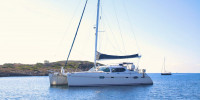
Can a Catamaran Capsize? The Surprising Answer
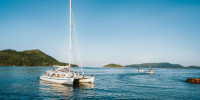
The Perfect Size Catamaran to Sail Around the World
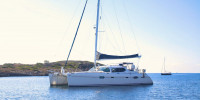
13 Best Liveaboard Catamarans (For All Budgets)
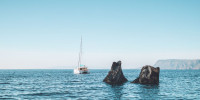
Average Cost of Buying & Owning a Catamaran (With 4 Examples)
Yachting Monthly
- Digital edition

Best multihulls: We pick the best two and three hulled yachts
- Rupert Holmes
- June 29, 2022
Rupert Holmes picks the best multihulls for cruising focussing on the most popular and interesting mid-size multihulls from 37-43ft

Few of us can have failed to see the rapid growth of interest in multihulls and this formerly niche sector is now a mainstream part of the new boat market.
Much of the appeal is obvious and is unchanged from the reasons for the popularity of Prout and other catamarans in the 1970s and 1980s, including spacious single-level living spaces offering great views. Today’s boats are also characterised by expansive outdoor seating and entertaining areas. These areas benefit from the near-universal adoption of the same fabric technology that enables motor yachts to leave cockpit cushions outside in all weathers.
Superior space
The full forward cockpit featured on a number of heavier and larger designs may appear to be a gimmick at first sight, yet they are practical in a number of ways. Firstly, a separate area can be ideal when sailing with larger complements of people on board – teenagers for instance may value a separate area. Other popular attributes include the amount of stowage on deck – ideal for those who want to carry a lot of watersports equipment.
In addition to decent cockpit lockers, you can expect to find a pair of deep lockers at the front of the bridge deck, plus further stowage in the bows. On boats above 42ft these areas are often large enough for conversion to single cabins, although it’s worth remembering that putting too much weight forward will compromise performance and the motion of the boat at sea.
Easy handling both under sail and power is an equally important theme. Twin engines make a cat easy to spin in its own length and handling in reverse is as easy as going ahead. This set-up also offers a degree of redundancy – if one engine fails you will often be able to reach port using the other one.
In some cases the nav station in the bridge deck saloon is an ideal place from which to con the boat while on watch in inclement conditions, making these boats as good as a conventional motor sailor in this respect, but with the potential for much better sailing performance. However, some designs lack the all-round visibility to make this feasible.
The International Multihull Show, which takes place in April at La Grande Motte, France, is a must for anyone serious about buying a new or recent boat. Although the show has a compact feel, it’s the only place in the world where dozens of multihulls of the same size can be compared side by side.
The impact of COVID
The British brokers I met at the show were universal about their experience of the UK market, which has changed considerably post Covid.
Their biggest client base for multihulls are now owners with plans for long-distance cruising. The increase in people working from home is also attracting a younger clientele than typical boat buyers, which is helping boost demand to unprecedented levels.
‘We’re seeing a big change in the way people are buying boats and what they’re looking for,’ Graham Laver of Ancasta, Lagoon’s UK agent, told me. ‘Most are not weekend sailors and don’t need a permanent berth – they have a lot more time on their hands.’
A scarcity of suitable berths in parts of the UK is therefore not a hindrance on this part of the market.
The major catamaran builders largely disregarded boats under 40ft for many years; however, there are welcome signs this attitude is changing. The Excess 11, unveiled at the 2020 Düsseldorf boat show, is a 37-footer by a new Groupe Beneteau brand that’s aimed at a younger audience than typical buyers of this value. It’s Excess’ first all-new design – the earlier 12 and 15 were based on the bottom third of Lagoon hulls, although almost everything above the waterline was new.
As with the two older models, there are helm stations aft in each hull, with wheels positioned right above the rudder stocks to produce the most direct feel possible.
The boat also has excellent visibility from the helm and is noticeably better in this respect than most cruising catamarans. Interior accommodation includes a well-proportioned bridge deck, with very generous headroom. There’s space for a decent galley, a full-size internal saloon area and a forward-facing navigation station.
On the downside, it lacks space for the ease of circulation of people seen on some larger boats and will therefore have more of an ‘excuse me’ factor when sailing with a full complement of crew.
Sensibly no attempt has been made to create peninsula beds in the aft cabins, so despite the boat’s relatively modest size both double beds measure a massive 2m by 2m. The huge stowage volumes under the bunks are easily accessed thanks to hinged top panels supported by gas struts, which enables far more of this space to be reached easily than the typical single drawer in the bunk front.
On the three-cabin design the starboard hull is given over to the owner’s suite, which includes a good desk/dressing table area and lots of extra stowage. Perhaps surprisingly, this doesn’t have the feel of living in a narrow tunnel – it’s a wide rectangular area that offers more comfort and practicality than many larger yachts.
Excess is also engaging directly with its client base via the Excess Lab. The online element of this discusses key issues that impact design choices, allowing the boating public to present its views in a way that helps inform development of new models. Recent topics include the balance between draught and windward performance, self-tacking jibs vs genoas, and refrigeration.
Excess 11 specifications
Price: €310,660 ex VAT LOA: 11.42m / 37ft 5in Hull length: 11.33m / 37ft 2in Beam: 6.59m / 21ft 7in Draught: 1.15m / 3ft 9in Displacement: 9,000kg / 19,800lb Builder: excess-catamarans.com
The chances are that if you’ve sailed multihulls of around 40-44ft at least one of them may have been a Lagoon. More than 800 Lagoon 42s have now been delivered, with the model proving equally popular with private and charter owners. It offers lots of space, even by multihull standards, in three- or four-cabin layouts.
Large platforms aft make boarding from a pontoon, quay or tender easy, while the big cockpit has multiple seating areas and plenty of space for easy circulation of people. There’s also a neat lifting system for the dinghy. The boat is sailed from a raised helm position on the port side, which has direct access to the winches. The two-person helm seat is configured to work well both when seated and when standing.
While this ease of sail handling is a key attraction for owners of most cruising- oriented multihulls, a downside of some raised helm stations is they can feel very removed from other people on board.
This can make others on board feel like passengers who are not fully involved in the sailing. Unlike a number of boats of this size, there’s no forward cockpit, but there is foredeck space for sunbeds that forms a separate area for socialising.
Interior bridge deck accommodation includes a decent galley to starboard, plus a generous forward saloon. This has a great view forward and to the sides, although vision is obstructed on both quarters, which limits the usefulness of the forward chart table as a place from which to con the boat when on watch in bad weather.
Even by the today’s standard of catamaran, accommodation in the hulls is very generous. The boat at La Grande Motte had the classic four-cabin, four-bathroom charter layout. Both aft cabins rival those of the owner’s cabin of many 50ft monohulls thanks to big peninsula beds and plentiful stowage. These are also airy and very well lit spaces, with an overhead hatch, big hull window and wide stern window.
Lagoon 42 specifications
Price: €426,600 ex VAT LOA: 12.80m / 42ft 0in Beam: 7.7m / 25ft 3in Draught: 1.25m / 4ft 1in Displacement: 12,100kg / 26,700lb Builder: cata-lagoon.com
The Neel range of trimarans is one of the most eye-catching of modern multihulls. The basic philosophy is hugely appealing – use performance trimaran hull shapes to create a platform for a spacious cruiser, while keeping the boat as simple as possible. Weight is also minimised, but in a practical way that doesn’t resort to eye- wateringly expensive high tech solutions.
I sailed one of the first 43s from La Rochelle last summer and found it a surprisingly rewarding boat to sail, with a feel on the helm akin to that of a monohull, yet it was significantly faster. On a reach in 14 knots of true wind we made a very relaxed 10 knots of boat speed reaching under only mainsail and jib. When the breeze picked up to 16-17 knots we were hitting a consistent, but relaxed, 11.5 knots at a true wind angle of 115º with an asymmetric spinnaker set.
Heel angles are greater than for a catamaran, as lifting the windward ama out of the water is an enormous help in reducing wetted surface area. However, monohull sailors will find the heel very modest and once it reaches 12-14º the boat is rock steady, even in gusts.
The amas of the 43 are too small for accommodation, so this boat has a largely open-plan layout, although the owner’s cabin is in a separate area to starboard on the bridge deck. There’s also a double berth to port that would make an ideal den area for kids, plus a further small double cabin forward at a lower level in the main hull.
A key feature of all Neels is a separate engine room and technical area below the saloon in the main hull, which is ideal for maintenance and fault-finding.
These are often thought to be expensive boats, yet the 43 is priced at a similar level to many other multihulls of this size. It’s perhaps no surprise they are leaving the factory at the rate of one a fortnight.
Neel 43 specifications
Price: €359,000 ex VAT LOA: 12.9m / 42ft 4in Beam: 7.4m / 24ft 3in Draught: 1.5m / 4ft 11in Displacement: 9,000kg / 19,800lb Builder: neel-trimarans.com
Nautitech open 40
This innovative boat set new standards when it was first launched and was a key influence in establishing the DNA of the open concept, with a big indoor/outdoor area aft under a hard top, combined with a smaller saloon forward. The effect is to create a huge outdoor living space that provides shelter from the elements – whether intense sun or rain.
Today’s version still has the original hull shape, marrying this with an updated and restyled deck, plus improved interior design. Twin aft helm stations that provide excellent visibility by multihull standards are also an important element. They also enable easy contact with the rest of the crew while you’re steering and there’s little barrier to stop them pitching in to help with deck work. This is therefore a sailors’ boat, with relatively narrow, easily driven hulls, high bridge deck clearance and deep rudders, even though it has fixed keels and not daggerboards.
Of course the nature of this boat means there’s less space for fully enclosed bridge deck accommodation. Nevertheless, it has a decent galley and in cold weather you can retreat into a cosy forward saloon, which has space for four to six people, plus an optional full-size drop-down dining table that makes a huge day bed. With an almost unobstructed 360° view, this also makes a good spot from which to con the boat in poor weather.
There’s a spacious and bright owner’s cabin in the port hull with a large double bed plus a dressing table/desk area. The starboard hull has a large double cabin aft and smaller one forward, which share a well appointed mid-ships toilet and shower. On some boats fitted out for long-term cruising the forward starboard cabin has been configured as office and/or workshop space.
Other boats in the range include a new 44 Open, which is based on similar principles, but has space for an impressively large galley and more volume in the hulls.
It also has numerous small improvements, including moving the mainsheet traveller from the hard top to the aft beam, which gives more precise sail control.
Nautitech open 40 specifications
Price: £404,795 ex VAT (sail away price) LOA: 11.98m / 39ft 4in Beam: 6.91m / 22ft 8in Draught: 1.35m / 4ft 5 in Displacement: 8,500kg / 18,700lb Builder: nautitechcatamarans.com
Marsaudon composites orc 42
A criticism often levelled at catamarans is that they lack feel on the helm and therefore aren’t fun to sail, but that’s not universally true. Lightweight boats with easily drivenhull shapes can be both quick and rewarding, with little of the noisy turbulence at the transoms and lack of pointing ability that can be associated with overweight models with grand accommodation and inefficient shallow keels.
This is the smallest in a range of three performance catamarans and was originally named the TS42. All three boats have direct tiller steering, combined with comfortable helm seats. They provide a great view of the sail trim, though the coachroof partially obstructs the view to leeward.
Despite offering 20-knot performance and the ability to cross the Atlantic in only 10 days, these boats also have lots of interior space. The 42, for instance, has a big bridge deck saloon, with a surprising large galley, plus an excellent forward-facing navigation station. When the weather dictates, this area is enclosed from the outer cockpit by canvas screens, thereby avoiding the need for heavy sliding doors. Equally, there are no moulded headlinings, though the deckhead can be faired to create a high-gloss finish that doesn’t add weight.
Both aft cabins have big double berths, while further forward the layout is flexible – owners can choose from additional double or Pullman style bunks, extra stowage, or extra-large heads and shower areas.
On the downside, these boats are built in small numbers on a semi-custom basis and lightweight construction, decent sails and quality deck gear are all expensive.
Marsaudon composites orc 42 specifications
Price: €520,000 ex VAT LOA: 13.05m / 42ft 9in Beam: 7.42m / 24ft 4in Draught: (fixed keel version) 1.5m / 4ft 11in Displacement: 6,400kg / 14,100lb Builder: marsaudon-composites.com
Fountaine-Pajot ISLA 40
Although launched last year, this model started life as the Lucia in 2016. However, it benefits from updates including a revised helm station that increases stowage – a move welcomed by many potential buyers looking at a boat for long-term cruising.
It’s raised up on the starboard side, with the wheel next to the halyard and sheet winches, making sail handling a simple matter when on watch alone. Steps up from the helm station give access to the hardtop for handling the mainsail, but there’s no option on this model for sunbeds up there.
There’s a large cockpit aft under the hardtop, with a substantial table on the port side. The foredeck has provision for sunbeds, but not a full forward cockpit. Stowage on deck is more restricted than on Fountaine-Pajot’s larger Astrea 42, but still far exceeds what’s available on most monohulls and includes two big bridge deck lockers, plus further space in the bows of each hull.
Bridgedeck accommodation includes a surprisingly large internal saloon, although this is achieved at the expense of a separate navigation station. The example at the show was a four-cabin, four head boat, but without separate shower stalls. Even so, to achieve this on a 40-footer is an impressive feat.
Both aft cabins have large peninsula beds, although floor space and stowage are reduced in size to give space for the two heads in each hull. Forward cabins have a double bed that tapers significantly at its forward end, but these are still far larger than the triangular forecabin vee berth of many monohulls.
Fountaine-Pajot ISLA 40 specifications
Price: POA LOA: 11.93m / 39ft 2in Beam: 6.63m / 21ft 7in Draught: 1.21m / 4ft 0in Displacement: 9,500kg / 20,900lb Builder: catamarans-fountaine-pajot.com
This 2020 design is another model that’s extremely popular in charter fleets. However, they are also sought after by private buyers and the numbers in the hands of individual owners will of course swell dramatically when they are sold on from charter operators.
As soon as you step on board this cat, it feels like a big boat for its size, with plenty of options for easy circulation of people. There’s arguably more separation between interior and exterior spaces than on many catamarans.
However, the Leopard 42 has a feature that few others offer in this size range. A full height door in the front of the saloon gives direct access to the large forward cockpit, which opens up the accommodation in a different way to most. This is also a semi-flybridge model, with an additional seating area on the hardtop that’s intended for use in port and at anchor.
A huge and very well appointed galley takes up almost half the saloon area and there’s further space under the floor to stow a considerable amount of dry supplies. There’s also a very good forward-facing navigation station/desk, although the internal seating area is relatively small.
The models that feature a three-cabin layout have a very impressive owner’s suite, which includes a large desk/dressing table, plenty of generous stowage and expansive floor space.
The other hull houses two double cabins, each with its own en suite and separate shower stalls. However, the downside of this arrangement is that there’s less scope to provide generous easily accessed stowage in these cabins.
Leopard 42 specifications
Price: POA LOA: 12.67m / 41ft 7in Beam: 7.04m / 23ft 1in Draught: 1.4m / 4ft 7in Displacement: 12,467kg / 27,485lb Builder: leopard catamarans.co.uk
This French yard set a standard by which all multihulls have subsequently been judged when it launched the Bali 4.3 Loft. It blends indoor and outdoor areas into a single vast space that can be closed off with the garage door-style aft bulkhead.
Since then the format has been greatly refined and the 4.2 offers impressively spacious layouts in both charter and owners’ formats. There’s also a full-size door to a spacious forward cockpit, with sunbeds extending the entire length of the solid foredeck.
Bali 4.2 specifications
Price: €424,780 ex VAT LOA: 12.84m / 42ft 1in Beam: 7.07m / 23ft 2in Draught: 1.22m / 4ft 0in Light displacement: 11,400kg / 23,100lb Builder: bali-catamarans.com
Aventura 37
This 20-year-old French-run but Tunisian-based company is one of the few that has actively addressed the market for smaller catamarans. The 37 is a semi-flybridge design with a big aft cockpit. It was launched a few years ago and is aimed at cruisers who want a spacious boat in a relatively compact package.
Nevertheless a key design criteria was an ability to sail at 7 knots in only 10 knots of true wind. The spacious accommodation includes lots of stowage, which includes a small walk-in wardrobe in the owner’s suite on three-cabin boats.
Aventura 37 specifications
Price: €237,500 ex VAT LOA: 10.9m / 35ft 9in Beam: 5.94m / 19ft 6in Draught: 1.2m / 4ft 0in Displacement: 7,900kg / 17,400lb Builder: aventura-catamarans.com
Enjoyed reading this?
A subscription to Yachting Monthly magazine costs around 40% less than the cover price .
Print and digital editions are available through Magazines Direct – where you can also find the latest deals .
YM is packed with information to help you get the most from your time on the water.
- Take your seamanship to the next level with tips, advice and skills from our experts
- Impartial in-depth reviews of the latest yachts and equipment
- Cruising guides to help you reach those dream destinations
Follow us on Facebook , Twitter and Instagram.
Yachting World
- Digital Edition

Best catamaran and multihull: We sail the very best yachts on two and three hulls
- Toby Hodges
- March 20, 2024
Toby Hodges takes a look at all the nominees and the winner of the best catamaran and multihull category in the much-anticipated European Yacht of the Year Awards
There are many categories in the European Yacht of the Year awards, from the best luxury yachts and performance yachts to the best yachts for families and event a best specialist yacht category. But with multihulls rapidly increasing in popularity, the best catamaran and multihull category was possibly the most hotly anticipated.
The small number of entrants in this category in no way reflects the rich range or huge demand for multihulls. Many new models were launched by the big yards in the preceding years and they’re struggling to keep up with bulging order books.
However, these three shortlisted represented a choice pick of the latest fast cruisers and each, in their own very different ways, are responding to this insatiable demand for high end space and pace cruising.
Best catamaran and multihull
Best catamaran and multihull winner 2024 – outremer 52.
My highlight test of 2023? Sailing this Outremer 52 for 200 miles over two days and nights! Quite how such a large vessel, one that is capable of doing laps of the planet in true comfort, is also capable of providing such enjoyable sailing is the secret sauce that helps scoop this prize.
And it was pushed hard for this award by the disruptive HH. But the Outremer is such a well rounded, measured and thought out yacht for bluewater cruising at a reliable speed – it’s the full package, a dream boat for family bluewater sailing and arguably the French yard’s best and most refined model to date.
Designer VPLP was tasked with replacing the popular and well proven 51 with more comfort and stowage, while maintaining the performance. It says it took the best of the 55 (which won this award two years ago), and the best of the 51’s deck plan to create this 52. The result means too many good features to point out here, from the variety of helm positions, including a completely protected position inboard using the swing pedestal, to the well conceived spaces. I’d therefore recommend reading our full test report online or in YW’s June 2023 issue!
Neel continues to enjoy its cruising trimaran niche, using the wow factor of bridgedeck accommodation combined with the type of sailing enjoyment and feedback monohull sailors appreciate.
The impressive lightwind performance and direct feel of a Neel I am used to. But I don’t think I’ve ever been so surprised by the amount of cabins or space as I was on this 52. It’s available with four to six cabins plus the option for two crew cabins aft! Some of this maze works well, other areas, such as the forward cabins in the main hull not quite so well. Horizon and rig sightlines and some finishing also leaves room for improvement.
The HH44 seemingly manages to achieve the space and pace balance in a compact 45ft package, while also being one of the most innovative and exciting new production yachts I have sailed. From its looks to layout, to practical on deck solutions such as swing pedestals, side gates through the bulwarks and transom gates that double as swim platforms and boost cockpit security, it’s packed with fresh thinking.
And on the subject of ‘fresh’, the natural ventilation encouraged into the yacht through those massive forward facing coachroof windows which open – a feat made possible thanks to a stiff carbon composite structure – negates any aircon requirements.
With its deep carbon boards and tall carbon rig the HH44 is a powerful, reactive animal to sail. However, it’s the incorporation of the first parallel hybrid electric drive units which really makes this high tech high performance cat stand out. The electric motors are attached to the aft end of conventional diesel engines, not only providing silent power, but renewable energy through regenerative drives while sailing.
Best catamaran and multihull 2023
Best catamaran winner – nautitech 44.
If the very best catamaran delivers the ideal comfort to performance compromise, here’s a catamaran that seems to strike the perfect balance.
For those who cite a lack of visibility and protection as reasons not to choose this aft helm route, try sailing this first – direct steering brings so much more helming pleasure that you get the enjoyable feeling and communication more associated with a monohull. The attention to keeping weight low and central, vacuum infused vinylester build and a low coachroof and boom all aid this performance. The fine entry Lombard-designed hulls allowed us to properly point upwind at 8 knots (in 13), but it was the hands-on steering sensation that really stayed with me.
While there’s no real inside/outside boundary – the saloon bridges both – the Chedal-Anglay interior design works well. It is not as voluminous as some, but is certainly enough to be smugly comfortable at anchor, finished to a good quality, with walnut Alpi trim as standard. The layout option for a ‘smart room’ office/laundry/bunk room or stowage cabin is indeed really smart.
Out of all the multihulls nominated or sailed last year, this cat impressed me the most under sail. It’s the ideal size to go distance sailing, with good performance, low draught and space for family and friends. It had me dreaming.
Balance 482
I was drawn to the Balance 482, thanks to the combination of good looking modern design, high average speeds and, chiefly, the profusion of clever thinking and practical ideas that it brings. The South African build uses a foam core with E-glass laminate and cored furniture for a light weight of 11.3 tonnes, but also with the ability to take a generous payload.
An electric furler option combined with screecher sail helps offer effortless handling and fun sailing, although the 482 prefers a breeze in the double figures. Smart options such as load cells on the rigging, a bowsprit camera to monitor the anchor chain, plus engine room and mast cams all help for maintaining vigilance. Other features we like include the solar panels properly installed on raised brackets, raincatchers built into the coachroof, and how all sheets and lines are led to the helm station. But the prize solution is the VersaHelm, which allows you to swing the wheel inboard, close off the helm station, and stand watch and steer from a fully protected position.
Catana Ocean Class
The Catana Ocean Class is a bulky model which is geared more towards creature comforts than the higher performance of its predecessors. That said, it uses carbon in the structure and roof, foam cored furniture, the tanks are mounted low in the hulls and it has daggerboards and fine entry bows. The weight savings help it offer a massive 5.5 tonne cruising payload, plus there’s capacious stowage and large tank, refrigeration and laundry capacity.
Positioned between Lagoon and Outremer, the Catana echoes a bit of its sister brand Bali’s concept with its internal cockpit-cum-saloon layout while providing good ventilation via large sliding doors and opening windows. We liked how it’s easy to handle solo from one helm station, including the electric remote control of the boards, plus the layout of the galley and navstation.
Those chasing speed and helming pleasure should perhaps look to the C-Cat 48, as it’s as close to helming a fast monohull as a cruising cat is likely to get and one of the rare times we enjoyed sailing upwind in light breezes on a multihull! This is largely thanks to a lightweight, stiff build – the Comar yard has managed to save 1.7 tonnes over the first boat (9.5 tonnes light) and increased the draught of the curved daggerboards to 2.95m.
A carbon roof and rig comes as standard, as well as an epoxy hull, full carbon deck, bulkheads and compression beam. It is a little quirky with comparatively small volumes, but this François Perus design will outperform most other performance cats and monohulls of a similar length.
The Excess 14 shares that direct sensation you get from aft helms and some of the performance of the C-Cat, but in a more balanced, voluminous layout for cruising. The Excess 14 benefits from the research of VPLP’s Vannes racing office, where attention was focused on weight reduction, with savings particularly in furniture, on improved stiffness (PET foam cored sandwich for main structural bulkheads), and the efficiency of deeper fixed keels.
The result is telling on the water, as it should be for any best catamaran contender, where you can log easy miles: we clocked late 7s upwind, reached in the late 8s and regularly averaged 9 knots with gennaker in 12-15 knots. Clear glass windows give acceptable visibility from the helms through the coachroof and the comparatively minimalist interior. In short it offers a good mix of volume, reasonable performance and enjoyable sailing – see our full review last month.
Sailing performance was another key facet in the battle of the big cats from the big cat yards, Lagoon and Fountaine Pajot. Both models offer luxurious amounts of space for home from home comfort, as watersports bases for long term cruising.
The decision to push the mast to the front of the coachroof to allow for a larger genoa than its recent preference for self-tacking jibs has paid off on the Lagoon 51. It helped us sail efficiently into the waves (albeit not pointing too high) before clocking double figures reaching with the code sail in 15 knots.
The Lagoon’s large flybridge with dual access is a USP at this size that will be a hit or miss deal breaker for many. The 51 offers unrivalled accommodation volume in three, four or six cabins, and relaxation zones, and good circulation through these big spaces. Once again the jury applauds Lagoon for thoroughly testing the prototype model during a six month tour. Over 100 have already sold.
We saw in our December issue how the experienced owners of the Fountaine Pajot test boat choose to live and work full time aboard their Aura 51. It’s a design that promotes space, enough to take friends, family and crucially for them, all the toys to enjoy at anchor. Its capability of averaging 8-10 knots also appeals, although the single side helm and hydraulic steering result in scant connection to the sailing in light winds (the same applies to the Lagoon).
The fact the yard already offers this in a hybrid version and has an electric and hydrogen model in the pipeline could sway some, but the decision between the FP and the Lagoon will likely come down to preference between a central flybridge or offset bulkhead helm together with interior design and layout.
If you enjoyed this….
Yachting World is the world’s leading magazine for bluewater cruisers and offshore sailors. Every month we have inspirational adventures and practical features to help you realise your sailing dreams. Build your knowledge with a subscription delivered to your door. See our latest offers and save at least 30% off the cover price.

17 Best Catamarans for Sailing Around the World
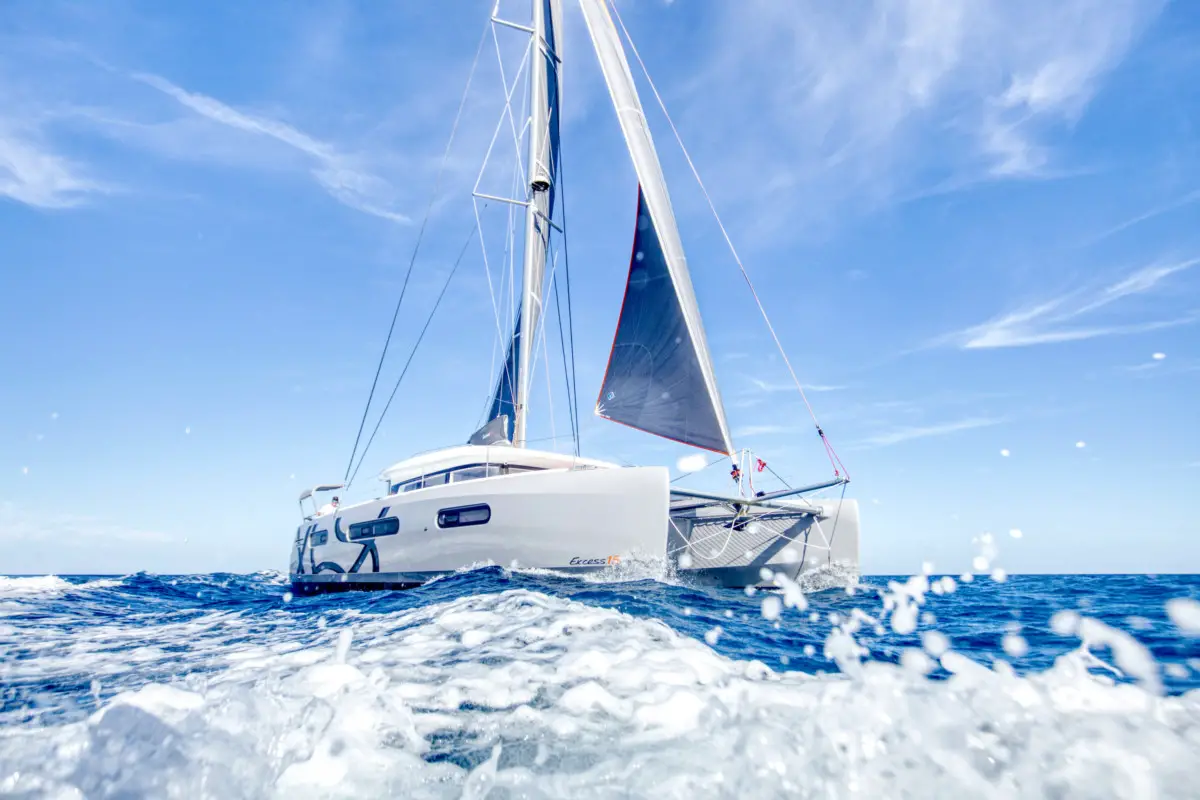
As an Amazon Associate, we earn from qualifying purchases. We may also earn commissions if you purchase products from other retailers after clicking on a link from our site.
Catamarans are quickly outstripping single-hull boats for long-distance journeys. They are more stable and comfortable , and some can travel more than 200 miles in a day. In today’s article, I have put together a complete (well almost) list of some of the best catamarans for circumnavigating the planet; the question is, which one is best for you?
The best catamarans for sailing around the world include:
- The Fountaine Pajot Ipanema 58
These cats focus on speed, safety, and comfort for longer journeys.
This article will show you the seventeen best catamarans for long journeys, and why they’re the best. You’ll also learn some great tips on what to look for in a Catamaran and how to save money by buying a used catamaran. Let this list be a jumping-off point for your future research!
Pro-tip; here are the actual costs of maintaining a cat and here are considerations on how to circumnavigate .
Table of Contents

The Best Catamarans for Sailing Around the World
A catamaran is a double-hulled boat with a deck or cabin area in between (bluewater cat definition in this article ). The double hull design means that the boat rocks less, sits higher on the water, uses less fuel to sail, and can be sailed in shallower waters than a single-hulled boat without worrying about grounding.
Catamarans come in a variety of sizes and can be sail-powered or motor-powered and range from single-person sailing boats to family-sized yachts. Every catamaran design is different, and the twin-hull shape offers many ways to customize the layout of a ship.
Each boat on this list is a larger catamaran (+40ft, more on size here ), so if you’re going to sail around the world, you want lots of space for provisions and rest.
Of course, there are tons of technical specs for each of these boats, but I’m going to focus on the overall features of each of these catamarans, what makes them stand out, and why they would each be an excellent choice for a transatlantic journey.
Antares 44i
The Antares 44i is an excellent option for sailing around the world and was explicitly designed for long-distance cruising. It performs well in any weather conditions, can be sailed easily by two people, and you’ll be able to sail long distances and live in comfort.
Although it can be easily sailed by a crew of two I believe that a true bluewater cat should be set up for single-handed sailing, more on that in another article .
This catamaran features a stateroom on each hull and a forward cabin with plenty of storage space. The living and entertainment features include a flatscreen tv and a high-end deck speaker system.
With this model, Antares dedicates itself to high-quality boats with optimal rigging and engine configurations.
Atlantic 42
Atlantic is no longer building this catamaran, but there are usually a few pre-owned boats on the market. You can also get it made custom if you love the design, but be prepared to spend more money on a custom boat (custom boat also gets custom problems ;)).
The Atlantic 42 is slightly smaller than some of the other catamarans on this list but is a seaworthy vessel. 42 ft is what most sailors I interview ( in this article ) said was the smallest cat to safely cross big oceans. It is also a decent size to counter the risk of capsizing (more on that here ).
It has a forward cockpit and pilothouse, which gives the owner a better use of space and makes the boat easier to navigate. With single-handed capability, one person can sail it easily and let the rest of the crew relax.
One of the best-praised aspects of the Atlantic 42 is its galley, more extensive than most 42-footers (12.8-meter) can offer.
One of the few 50 footers (15.24 meters) that can be sailed by just one person (many would of course disagree on this).
The Catana 50 is a catamaran worthy of an overseas journey. Its size adds to its stability on the open waters and its ability to sail straight through the choppy ocean and windy conditions.
The Catana is also incredibly spacious on the inside, with substantial cabins and showers. The biggest downside to the Catana 50 is its price, as it’s much more expensive than most of its competitors.
Catana also holds up well against some of the fastest cruising cats out there, here’s a list of the fastest cruisers if you are interested in that.
However, if you can find a gently-used Catana 50, you can rest assured that this boat will last!
The Dolphin 42 is unique because of the use of daggerboards instead of fixed keels. This upgrade means that the boat has some pretty decent upwind performance while at the same time being faster downwind.
Centerboards and daggerboards offer some interesting downsides compared to mini keels. This is an interesting discussion and I suggest you read another one of my articles if you want to deepen your knowledge a little.
These catamarans are some of the lightest on the market. Not many Dolphins were made, so they are relatively hard to find. However, if you want a small, lightweight boat capable of going great distances, the Dolphin 42 is an excellent choice.
Fountaine Pajot Belize 43
The Fountaine Pajot Belize is another well-built cruising yacht. Its core is made of foam instead of balsa, which reduces the risk of structural damage due to a rotten core in case of water intrusion.
The design of Belize offers many options for customizability, with large open spaces and a combined saloon, navigation, and dinette area.
There are two styles of Belize catamarans for sleeping quarters. You can either purchase a boat with an entire primary suite on one hull or one with two cabins in each hull. The first option is great if you are sailing the world alone and not expecting many guests, as it increases the storage capacity.
Understanding what factors to consider when getting a cat can be hard, there are just so many of them (such as the daggerboard discussion above), I have tried to compile some of the most important in this article .
The boat also has wraparound windows to increase the sense of space in the galley.
Fountaine Pajot Lucia 40
Fountaine Pajot is one of the best sailboat manufacturers existing today, as their boats are well made and highly versatile. The Lucia 40 is no exception – it’s a smaller boat but has a lot of room for moving around and on-board living.
The living area is remarkably spacious on this catamaran for its size.
The galley and lounge easily accommodate 6+people. The Lucia 40 doesn’t disappoint when it comes to sailing either, as the narrow hulls slice through choppy waters with ease.
Most catamarans today are built to withstand rough weather but that doesn’t matter as much if the crew isn’t up for the task, I firmly believe that the most important thing a boat should consist of, is knowledge. Therefore taking online courses ( two free here ) or reading books ( my favorites here ) is imperative.
Gemini 105M
Gemini’s boats have been on the market for years and are solidly built for cruising. This boat is one of the most popular ever made, I personally would consider something different for offshore cruising, but since it has such a good reputation, I felt I had to add it to the list.
If you want to understand why I am hesitant to take this boat around the world, I recommend you read my article: What are trampolines on a catamaran?
The Gunboat 62 is a great catamaran and set the standards for the rest of the impressive Gunboat lineup. It’s sleek and spacious while being robust and capable of transatlantic journeys. You can easily travel the world in a Gunboat 62 with several people and not feel cramped.
The yacht was made for speed and power and remains one of the fastest catamarans on the market, even rivaling the newer Gunboat models. GABO
Although the earlier models of the Gunboat 62 weren’t designed for a lot of cargo, you can still find space for everything you need without compromise.
Lagoon catamarans are known for their reliability and ease of use. If you are considering a catamaran for the first time and are unsure about the technicalities of sailing, a Lagoon boat is a great option.
The Lagoon 380 is probably the smallest cruiser on this list, which makes it better suited for solo or couple sailing.
When I go looking to buy something, whether it be a boat, campervan, or whatever, I create a checklist and classify all the things I want either by NEED or NICE to have.
I believe the Lagoon 380 to be sub-optimal for my NEEDS, even though it does check a lot of NICE boxes, there’s a step-by-step article on the NEED and NICE method here .
There are several cabin options available on the Lagoon 380, but if you’re sailing by yourself, you can settle for three cabins and a larger galley and living space. With a smaller cockpit and broader side decks, the Lagoon 380 packs a lot of practicality and ease of sailing into a more compact catamaran.
If you like the idea of a Lagoon boat but want a little more space, the Lagoon 42 is the upgraded version of the Lagoon 380. With all of the same benefits, it comes with more space for cabins or storage, making it one of the best-selling Lagoons of all time.
The Lagoon 42 is also a faster cruiser built for strength. While it’s not the fastest on the market, it works well in choppy waters and windy conditions, making it great for the beginning sailor to go on a more extended trip.
Many people have completed an around-the-world sail with this ship.
Although there is a flybridge version, I would recommend the “open” version due to several factors, some including increased windage and a higher boom. More on flybridges pros and cons here .
For stability, safety, and durability, you can’t beat the Lagoon 42.
The Leopard 45 performs better with less storage weight because of the relatively low bridge deck clearance. If the boat is fully loaded, you could experience some wave pounding. However, the cockpit is open and airy, with devices that block the sun and provide maximum comfort while sailing.
The Leopard 45 is an incredibly beautiful boat, and has a strong reputation for excellent build quality!
Leopard catamarans are one of my personal favorites, as such I have written an entire article about the brand, so if you want to understand its pros and cons then here is the link . Gabo
Designed in South Africa, it features a high rear arch for extra support and very smoothly connected decks. The galley is large and open, and most Leopards offer a four-cabin plan. If you are traveling with another person, this boat is an excellent option for you!
The Manta 42 is another classic catamaran that you can buy used (at a decent price), as it is an incredibly seaworthy vessel. While still in production, the Manta was one of the most popular catamarans on the market.
It is still in high demand amongst circumnavigators. Buying a used Manta 42 usually means that you inherit some of the previous owner’s boat upgrades!
The Manta 42 also made it to my list of the 9 safest catamarans on the market ( link ).
This blue water cat can be sailed by one or two people, making it ideal for liveaboard couples or long-distance shorthanded sailing. The galley is in the saloon ( instead of in one of the hulls ), making the cabins below more spacious and better equipped.
Overall, the Manta is well equipped for sailing around the world.
Nautitech 44
Nautitech is an excellent brand of the catamaran, with several different designs per boat. The Nautitech 44 has a unique feature, you can have it with two options for steering: twin wheels or a single wheel.
The Nautitech 44 also features a cockpit on the same level as the saloon. The door between the two is more convenient than a hatch and dramatically reduces the risk of water damage during rain pour.
This is also the same boat that aeroyacht president Gregor owns, he has offered some great insights into Nautitech in the book Catamarans (amazon link )
Outremer 45
Outremer is famous for being one of the fastest brands of catamarans on the market. If you need speed, the Outremer 45 might be the perfect choice for you. It has a top speed of 16 knots, which is higher than almost every other catamaran of its class.
While the Outremer 45 is known for speed, it doesn’t compromise on the quality of living.
You can settle into life on this boat with complete peace of mind. Even as a beginning sailor, the steering is simple and easy to use, and the autopilot is top of the line, so you’ll be able to sail across the ocean in an Outremer without issue.
Privilege Serie 5
A French-designed catamaran, the Privilege Serie 5 is one of the most comfortable 50-foot (15 m) yachts available. The unique cabin layout includes the master cabin in the boat’s center instead of in one of the hulls.
The Privilege Serie 5 is also incredibly easy to sail, despite its larger size.
The sails and controls lead to the helm, where the raised deck makes it easy to see all around the deck. If you want to cross the ocean with a full crew then the Privilege Serie 5 might be perfect for you!
Seawind 1000
The Seawind 1000 is the smallest boat on this list, measuring 33 feet (10 meters) long altogether. However, this doesn’t mean that it’s not livable. If you are sailing on your own or with a partner, there is more than enough space to live in the Seawind 1000, which includes the option of a centered cabin or two hull cabins.
Because it’s small, the Seawind 1000 is easy to handle. The mast and sails are all manufactured for extra stability and ease of use.
Overall, the Seawind 1000 is an excellent example of a simple, safe, and seaworthy catamaran.
Note: since this is a small catamaran it will also be more sensitive to heavy weather so trip-planning becomes even more important.
The Voyage 44 is one of the oldest cats on this list, having had its hay-day in the mid-1990s. However, this also means that a used Voyage 44 will be cheaper than a newer boat. If you can find a Voyage with previous responsible owners, you will inherit any upgrades and fixes that they’ve made on top of a very seaworthy boat.
The Voyage 44 has more storage and space than most cruisers of its size and is known for behaving very well in choppy waters.
This catamaran does its job well while providing adequate space for cooking, sleeping, and living aboard.
What To Look For in a Long-Distance Cruising Catamaran
If you are planning to sail around the world, you need to be very careful about which kind of catamaran you decide to use. Many of the things you want in a boat really comes down to personal preference, so be sure you know what design preferences you want before you start shopping!
Size and Payload
The most important thing to consider when buying a catamaran is how much space and cargo you need because the larger the boats are, the bigger the payload it can handle. Decide how long you want the ship to be and how much you’re taking with you.
It’s vital not to overload a catamaran, this will reduce performance and increase risk of unwanted behavior in heavy seas.
Cabin Placement
Most catamarans have options for a “Maestro” cabin placement, where one entire hull is the master suite, and the other cabins are located on the opposite hull.
Cockpit and Protection From The Weather
Is the cockpit on the boat you’re looking at covered or open? This can make a difference on the high seas, especially during rainy weather.
The size of the ship also can affect how many people you need as a crew. If you’re traveling by yourself or with one other person, you don’t want to buy a boat that needs a larger crew.
Buying Used?
If you don’t want to spend the money on a brand new catamaran, I don’t blame you. Several of the ships on this list are out of production and can only be found used. However, for circumnavigation, you do want a boat of high quality to keep you safe and dry until you make it to your destination.
When buying a suitably used catamaran, it’s essential to look at the refit history of the boat more than the year it was made. Catamarans are sturdy, and the general design has been the same for at least the past decade.
If you find a newer, larger, cheaper boat, you should look into its history.
Your best bet to save money while buying a catamaran will be to buy an older, probably smaller boat with an excellent refit history and no serious issues. It will still be an investment, and a sturdy used catamaran will serve you well.
Final Thoughts
No matter which catamaran you decide to buy for your journey, you’ll be able to sail safely and comfortably. Catamarans are great yachts for long-distance sailing, and the ships on this list are the best of the best. These brands are time-tested and ready to accompany you on an adventure around the world!
Here are Some of My Favorite Catamaran Cruising Resources
Thank you for reading this article. I hope you found it helpful as you hopefully start your sailing adventures. Here are some resources that I use as a sailor that I hope you’ll also find helpful. These are affiliate links, so if you do decide to use any of them, I’ll earn a commission. But in all honesty, these are the exact things that I use and recommend to everyone, even my own family. Sailboats: If you’re looking for the best boat to suit your needs, I would recommend a catamaran. If you’re interested, I can show you the differences between catamarans and other types of sailboats .
Books: For getting started, I really like Cruising catamarans made easy . It is actually a textbook from the American sailing association; it is used to get a cruising catamaran certification. There are some other great books, and I have compiled a list of books about cruising catamarans that you will find useful.
Communication: Being out on adventures, whether it be sailing or climbing mountains, good communications are essential to being safe. I recommend two things Google fi (incredibly simple cellular data all over the world) and Garmin inreach mini (for text and voice in remote areas without cell coverage)
Sailing courses: Online sailing courses are great for beginners starting out their sailing career; it’s an efficient way of learning the basics of navigation, throttle controls, and maritime safety. I suggest starting with two free courses from NauticEd .
To see all my most up-to-date recommendations, check out this resource that I made for you!
- Wikipedia: Catamaran
- Cruising World: A-Z Best Cruising Catamarans
- Dreamy Yacht Sales: Four Best Catamarans for New Buyers
- Atlantic Cruising: Good Cat/Bad Cat
- Yachting World: Catamaran Sailing Across the Atlantic
- Boat Affair: What is a Catamaran?
- Nautilus Sailing: Catamaran Sailing
Owner of CatamaranFreedom.com. A minimalist that has lived in a caravan in Sweden, 35ft Monohull in the Bahamas, and right now in his self-built Van. He just started the next adventure, to circumnavigate the world on a Catamaran!
3 thoughts on “ 17 Best Catamarans for Sailing Around the World ”
I like the efforts you have put in this, regards for all the great content.
Thanks Elisabeth I really appreciate the kind words 🙂
I appreciate you sharing this blog post. Thanks Again. Cool.
Leave a Reply Cancel reply
Your email address will not be published. Required fields are marked *
Save my name and email in this browser for the next time I comment.
Recent Posts
Must-Have Boat Gear for Catamaran Sailors!
Sailing is probably the most gear-intensive activity I've ever done; there are so many decisions to be made about what gear to buy now, for tomorrow, and what to definitely never buy. The gear on...
6 Best Trailerable Trimarans For Bluewater and Coastal Sailing
Having a boat costs a lot of money, even when you are not using it, marina fees, etc. And once it is in the water most sailors never go very far from their "home marina" and sailing will be somewhat...

26’ FRANCES. A small double-ended cruiser.
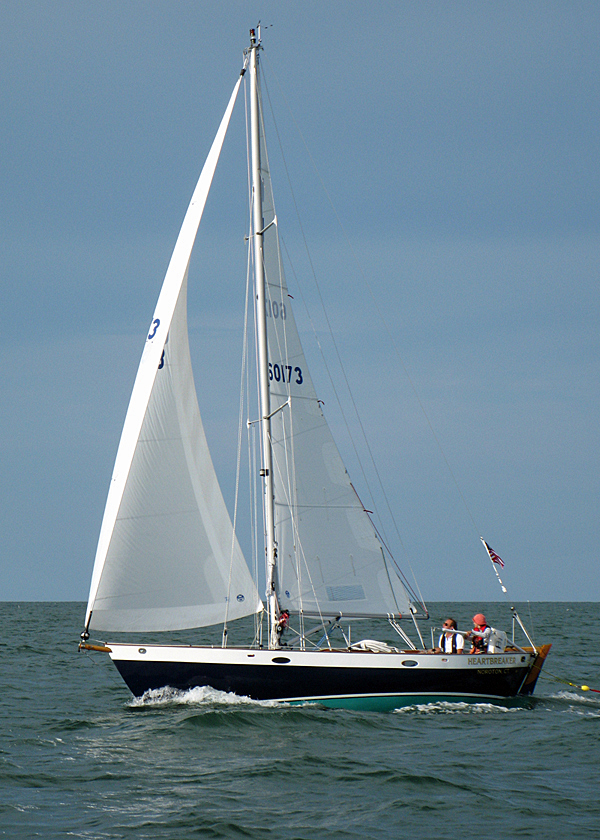
HULL NUMBER 1 of the Frances design, built by Tom Morris in 1975. It had a custom tall, double spreader sailplan, no pulpits, and beautiful sails, for racing.
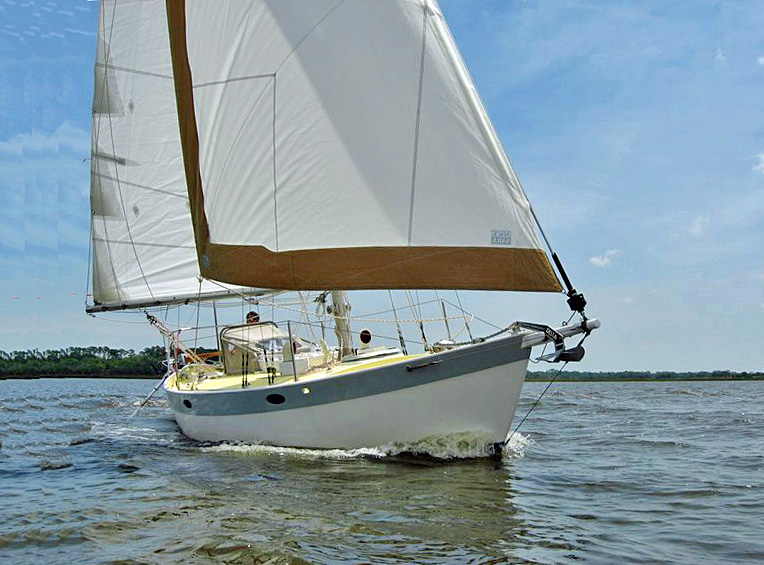
LALUZ. A flush decked Frances that has sailed more than halfway around the world.
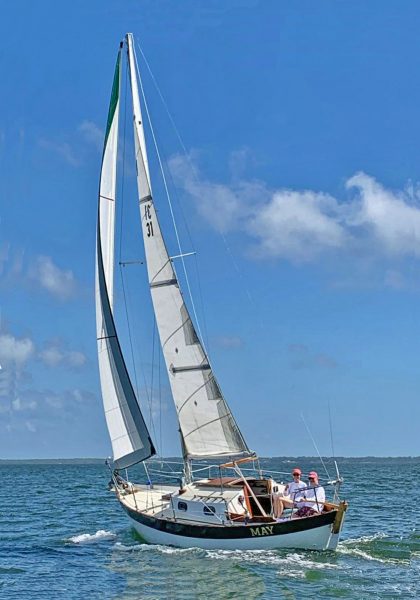
THE TALL RIG boosted performance in light airs, but required a reef much sooner when the wind piped up. The majority of FRANCESes had a short house so you could stand up in them.
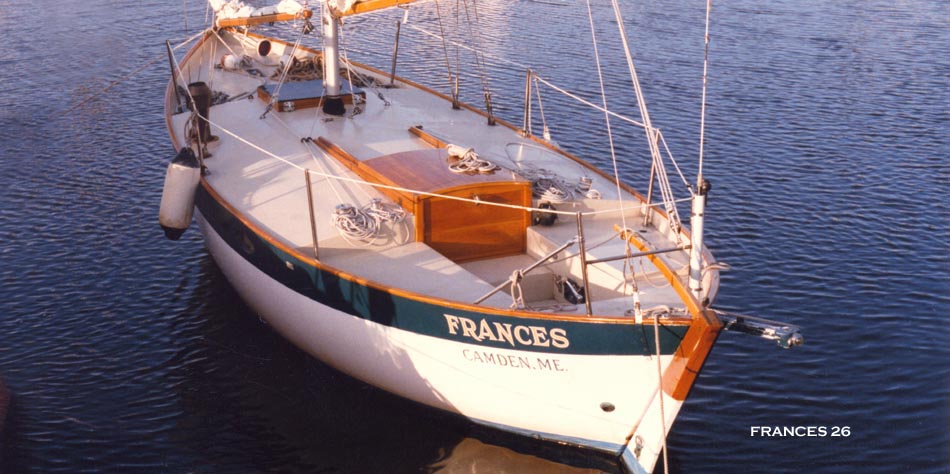
The second FRANCES was fractional sloop rigged with a self-tending jib. The first few FRANCESes were flush decked like this. When a short house was added with full headroom (if one was less than six feet tall), and more efficient sailplans were designed, interest in the boat blossomed. Before all was said and done, more than 200 yachts were built to this design.
ORIGINAL FRANCES DIMENSIONS
LOA: 25′ 10″
LWL: 21′ 3″
BEAM: 8′ 4″
DRAFT: 3’ 10″ (NOW 4′-1″)
DISPLACEMENT, as built: 6,800 lbs Full load 7300 lbs (approx)
BALLAST (lead): 3,500 lbs
SAIL AREA (100% foretriangle): 317 to 340 sq ft (varies)
DISPL/L RATIO: 316 – 330 (varies)
SAIL AREA/DISP RATIO: 14.5 to 15.6 (varies)
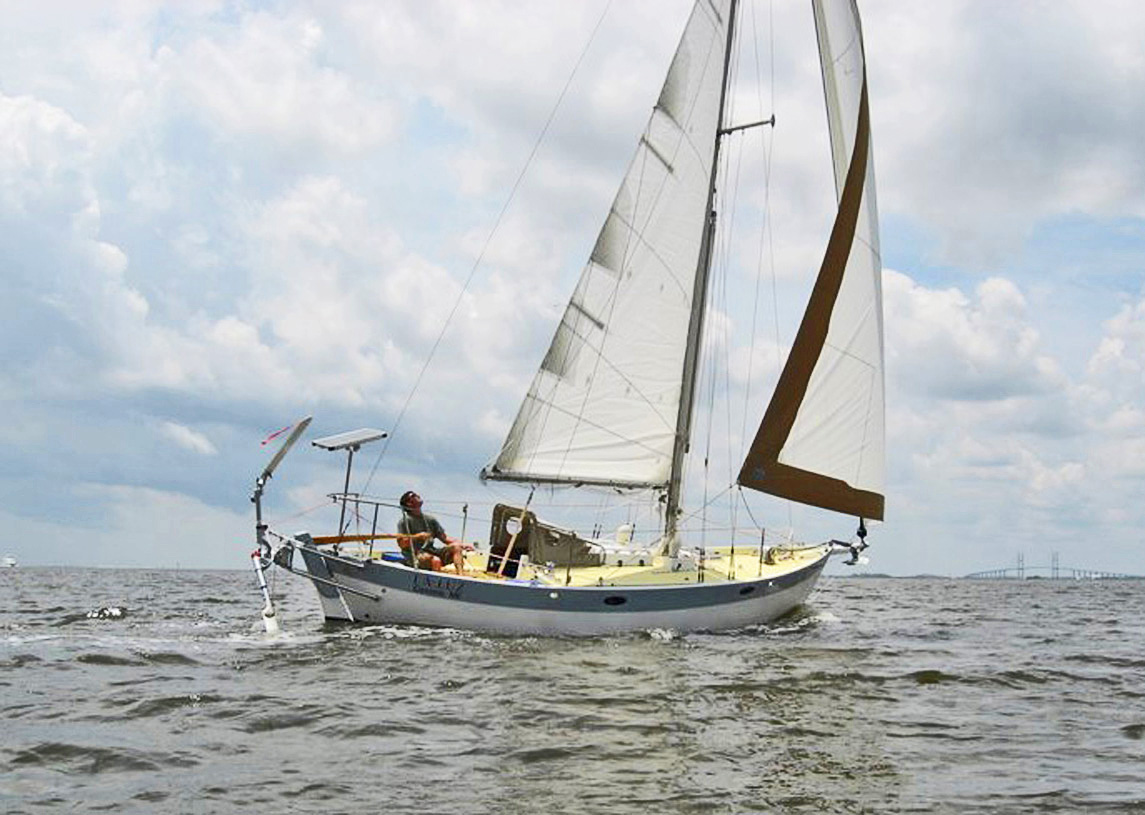
LA LUZ cruising in the tropics. She sailed from Maine to New Zealand.
The FRANCES is one of recent history’s most admired small cruising designs. Well over 200 of the small yachts are now sailing, and they are well loved wherever they voyage. I decided to design this small but capable cruising boat in 1974. My own boat was flush-decked, and I cruised it from Maine to Rhode Island. Another (LA LUZ) is halfway through a circumnavigation. A third (YANLI) has sailed from England to Australia and then to Hawaii and back to Australia. Many of the sisterships added a small house for full headroom, and a variety of sailplans have been fitted.
FRANCES es were built in fiberglass by Morris Yachts in America and Victoria Marine in the U.K. Quite a few fine examples were custom built from our plans of cold-moulded wood using the WEST system.
And now, in her dotage, new aspirants are restoring these fine old boats for their own adventures. Sailing the open ocean in such a small boat is borderline foolhardy- though many have successfully crossed oceans. But if you are aware of the discomforts of facing a storm at sea in something of this size, and are aware of the many advantages of a small, manually handleable yacht, the Frances is one of the better alternatives.

The lines of the original FRANCES.
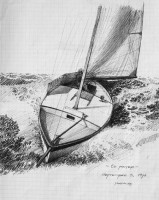
A preliminary sketch for the first FRANCES .
I often ponder what it might be about the FRANCES design that makes it so popular. I think it must be the aesthetics first and foremost. But the real surprise is how well it sails. Nearly half of her weight is ballast, and it is made of lead. So despite her shallow draft she is reasonably stable and surprisingly fast. Of the various rigs the ones with larger headsails and smaller mainsails proved to be the faster and more weatherly, at the expense of more work trimming, of course. Some of the earlier sailplans were frankly overcanvassed, and a new sailplan, designed in 2020, offers more drive with less heeling,
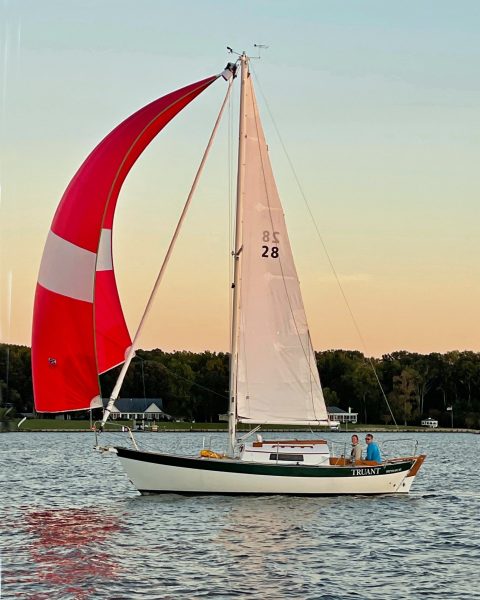
YOU COULD add a spinnaker, and then you could race her. With a shallow keel and a lot of wetted surface, racing the short-rigged Frances is an exercise in futility. But it’s colorful and if there’s not a lot of windward work, you might just possibly collect silverware.
In the last year I have been contacted by three Frances owners who want to improve their 45-year-old boats, and one who intends to build a new one. The biggest improvement among many small ones is to fit a carbon fiber mast and a new sailplan. This new rig falls about halfway between the old short and tall rigs. It specifies a roller-furler for the jib and a genoa, and a solid vang for the boom, plus a deployable Spectra inner forestay and Solent jib for windier conditions. If you own an old Frances and want to improve it, or can buy one for a reasonable price but are realistic about the significant cost to bring it up to date, contact the designer and invest in a new rig and sails that will significantly improve your boat’s performance, and leave the political craziness and economic uncertainty of life ashore behind.
The original FRANCES hull is pared away in width below the points where the cabin sole needs width and the fairing radius between keel and hull is tight. This is a shape without a lot of form stability, so the FRANCES compensated with an unusually low center of gravity thanks to 3500 pounds of lead ballast.
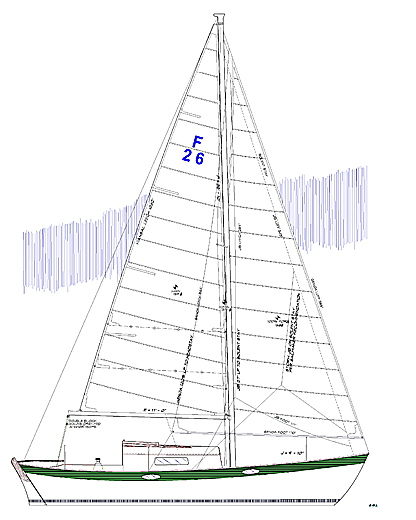
THE NEWEST SAILPLAN. It uses a carbon fiber mast and simplified rigging with sweptback spreaders, a single aft lower shroud, and larger diameter stainless steel rigging. The offshore or inshore mission of each boat can be addressed by the amount of overlap of the genoa. This particular boat’s owner anticipates heading off on an immediate ocean crossing, so the genoa is of modest overlap and a deployable Spectra stay and Solent jib are available for heavy weather.
I adored my little FRANCES . She was beautiful, well mannered, stable enough, and just plain fun. Her sleek lines cut through resistance like a dreadnaught. Point FRANCES toward a destination and she was unstoppable. Her timeless virtues seem to have disappeared from the modern world. They just don’t build ’em like FRANCES anymore.
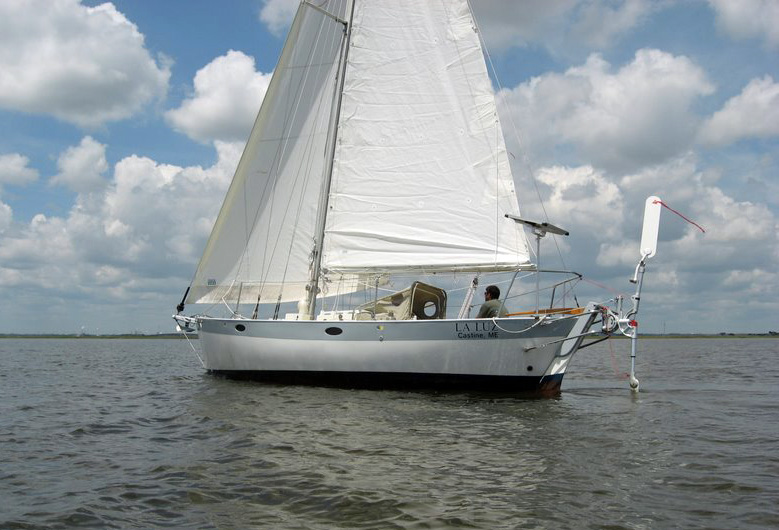
LA LUZ had a big genoa so she goes very well in light airs. She spent five years sailing in the South Pacific and ended up in New Zealand.
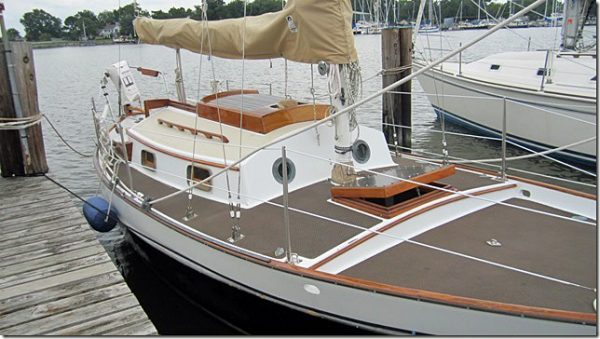
THE NEW VERSIONS will have a short cabin very similar to this, perched atop the midship raised deck. The perception of space this lends to the interior is quite amazing.
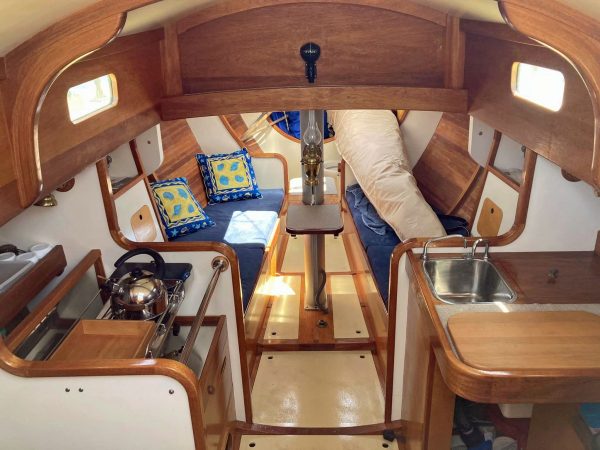
WITH THE SHORT, almost 6-foot headroom house, the interior of a Frances could feel much larger than you’d expect on a 26-foot boat. This is a custom WEST-system boat built in New Zealand.
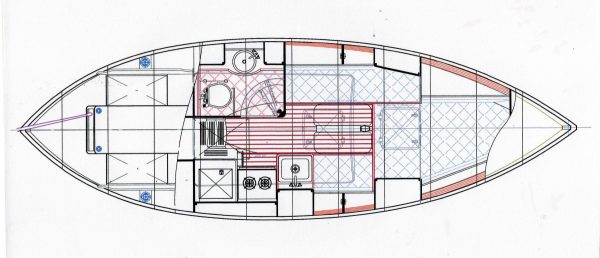
The Aft Head arrangement for the Frances with one seaberth and a permanent double. (Note: The companionway steps may have to be slid forward depending upon your choice of propulsion).
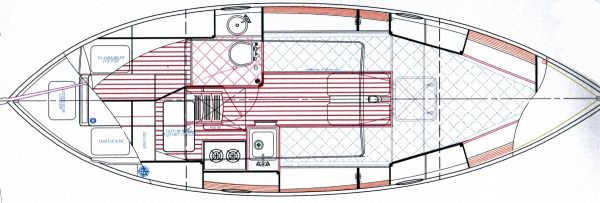
The Aft Head arrangement for the Frances with two settees, and a large double berth forward. (Note: The companionway steps may have to be slid forward depending upon your choice of propulsion).
The original FRANCES is a highly respected, classic design. She’s comparable in many ways to an MGTD or a J3 Cub. They spewed oil and weren’t very fast by today’s standards, but they were so cute and stylish and safe that owners have enjoyed every minute of their use for decades. The hullform is conventional, heavily ballasted , with no concessions made for speed. It has a CSV (capsize screen value) of 1.70. Anything less than 2.00 is considered a good choice for offshore voyaging.
This design is featured in both of my recent books; MY YACHT DESIGNS and the Lessons they taught me, and THE BOATS I’VE LOVED— 20 Classic Sailboat Designs by Chuck Paine. Both are beautiful, full colored, first class books which give you lots more information on this design, and can be purchased on this website.
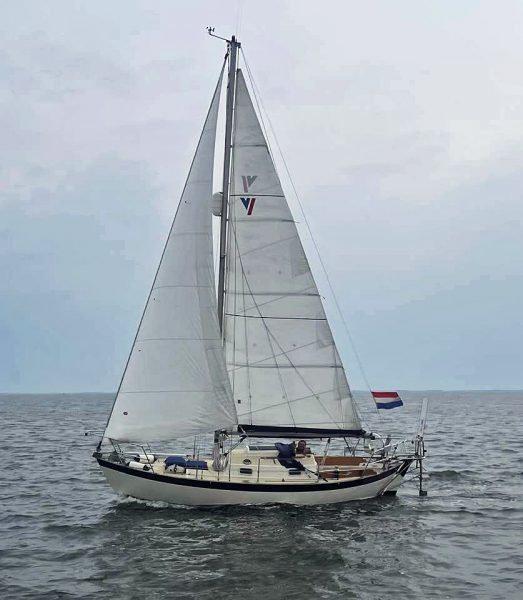
QUITE A FEW sailplans have been fitted to a FRANCES. This is one of the “tall rigs”, which could even be raced, and really got the boat going in light to moderate airs, but are too overcanvassed for offshore voyaging. If your idea is to sail around the world, the more conservative rigs, with a three-foot shorter mast, would require reefing less often.
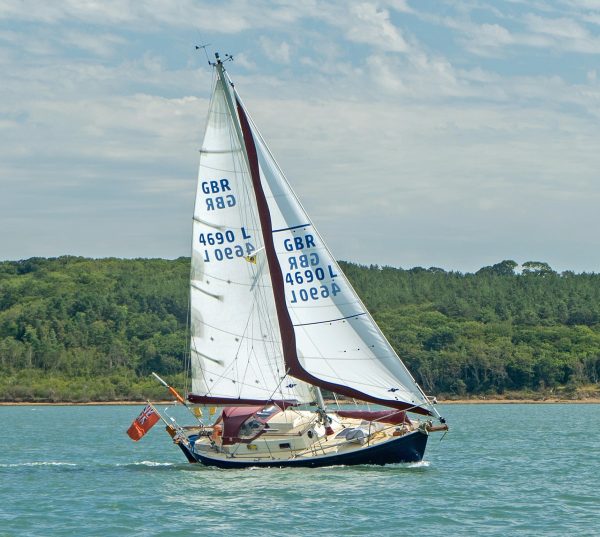
A British built cutter rigged FRANCES. photo credit Charlie Whiteman
FOR MORE PHOTOS OF LA LUZ , A FLUSH-DECKED FRANCES THAT HAS BEEN SAILED HALFWAY AROUND THE WORLD, CLICK HERE:
http://frances26.org/laluz.php
Further information may be obtained from:
CHUCKPAINE.COM LLC Tenants Harbor, Maine 04860-0114
To email Chuck:
A LONG, FUN HISTORY OF THE FRANCES 26 DESIGN
You’ll find great histories of the FRANCES design in both of my books, available as digital downloads from this website. But a recently formed Facebook Group called The Chuck Paine Yacht Designs Fan Club has produced all sorts of photos from owners all over the world, and a few interesting anecdotes. With the benefit of these gifts from the 48-year history of the Frances design, here is a much longer story, told mostly in pictures..
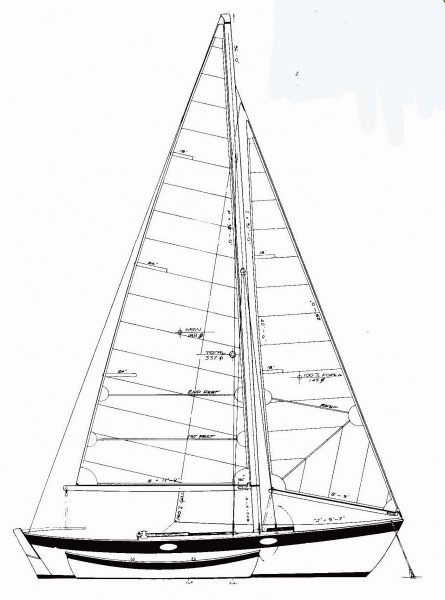
The first of many eventual sailplans had a tall fractional sloop rig with a self-tending jib set on a jibboom. This worked okay before jib roller-furling became popular, but the boomed jib gave up some potential sail area and the tall mast was heavy and required a lot of rigging with its weight and windage.
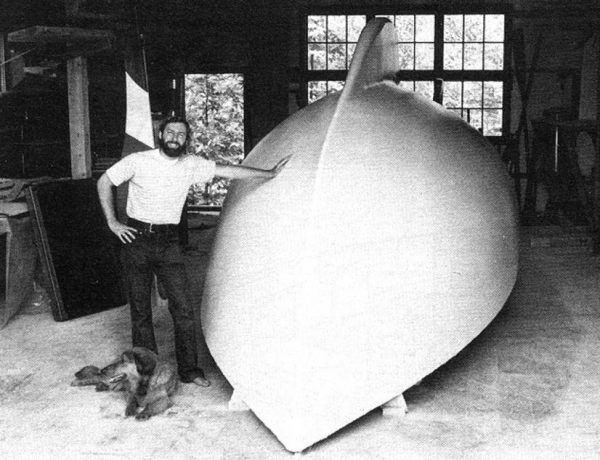
THERE I WAS at age 30. Young and ambitious, I’d come up with an idea of what life was about for me. Design a new yacht, build a prototype in my beautiful rented shop, sell it to one of the many emerging fiberglass boatbuilders and do it all over again. With my superb shop full of the finest tools someone else’s money could buy, a pretty girlfriend who looked like she might stick around, and my loyal dog Shep at my feet, what could possibly go wrong?
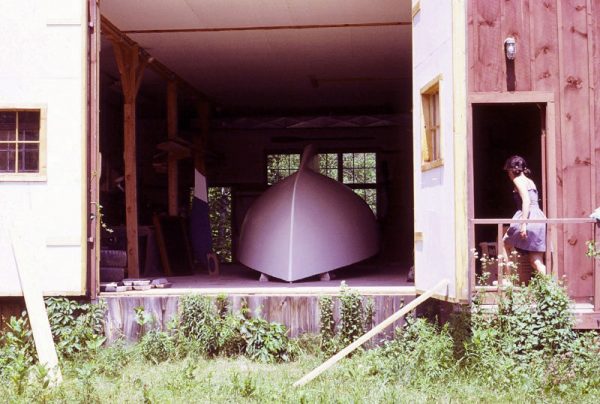
IN 1973 I had recently quit my job working for Dick Carter as a draftsman. I’d met this girl (now my wife) and decided to take her on a backpacking trip from Scotland to India. I had this idea that when we returned I would take my life savings and design and build a boat. The Westsail 32 had become a life-changing phenomenon for sea-seeking vagabonds, and I figured what the world needed was a smaller, more affordable double-ender. 26 feet was all I could afford so that determined her size. I lucked out and was able to rent this beautiful, heated and insulated shop full of the best woodworking tools for next to nothing. This shows the nearly finished hull upside down in midsummer of 1974, when I met this guy named Tom Morris who was getting started as a boatbuilder and fell in love with the design. We made a handshake deal that he would take a fiberglass mold off my hull, invest in a lot more tooling and a ballast mold, and I would press on and finish my boat in time for me to take it to the Newport Boat Show in September, and we would both become rich and famous. In the end, luck intervened.
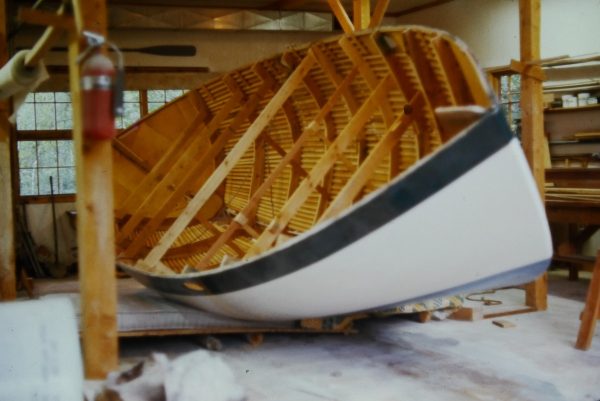
AFTER TOM MORRIS had taken his mold off my hull the day came to turn her over.
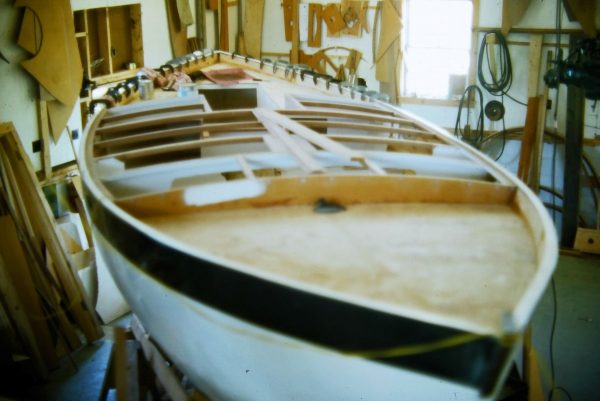
AS THE SUMMER wore on my boat was nearing completion. Her hull was built using the then popular foam core over stringers method, with a conventional glass covered plywood deck over frames.

WITH MY BOAT NEARLY FINISHED, the shop burned to the ground. Gone were my new boat, my life savings, all my tools, my landlord’s beautiful shop that I had planned to live out my life in, and my newfound livelihood. But I dusted myself off and determined to take the insurance settlement and build another Frances in the Spring.
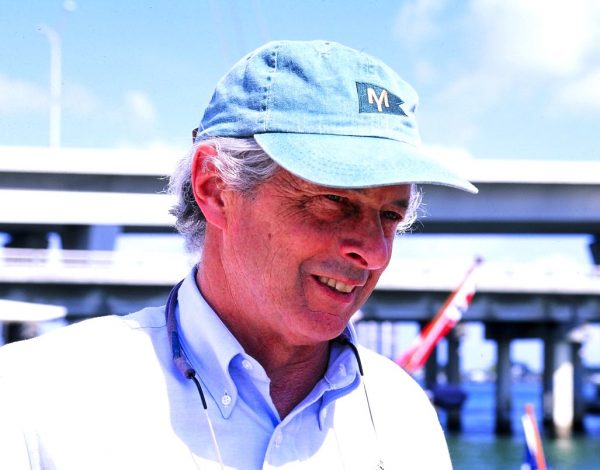
IN A STROKE OF GOOD FORTUNE I had met Tom Morris and he had committed to building new Franceses. When he heard about the loss of my boat he offered to sell me a hull from his new mold at cost, and space in his shop in Southwest Harbor in which to complete it. I hired my twin and he moved to Maine to help me get it built. We worked together for six months of intense work and got her finished in time to show her at the 1975 Newport Boat Show. Tom and I sat together on the side deck for four days and sold boats… it was that easy back in the halcyon days of fiberglass boatbuilding.
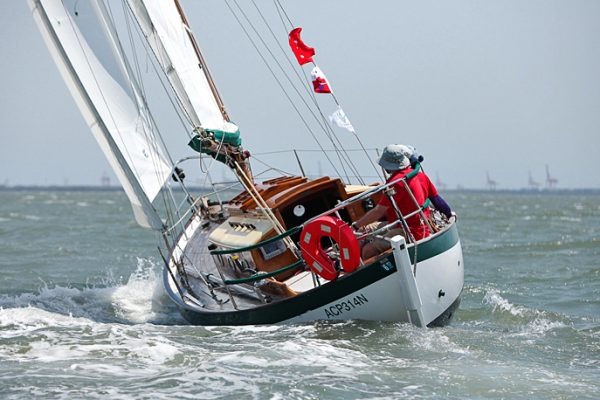
WHEN CUSTOMERS CAME ALONG who wanted to build a FRANCES of some other material than fiberglass, I would sell them the appropriate plans. Most of these customers hailed from other parts of the world. This one is Tom Thumb , built in Australia.
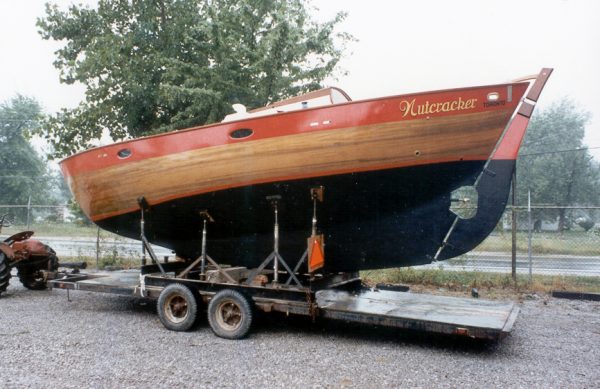
NUTCRACKER was built in the WEST System by a lady sailmaker from Toronto.
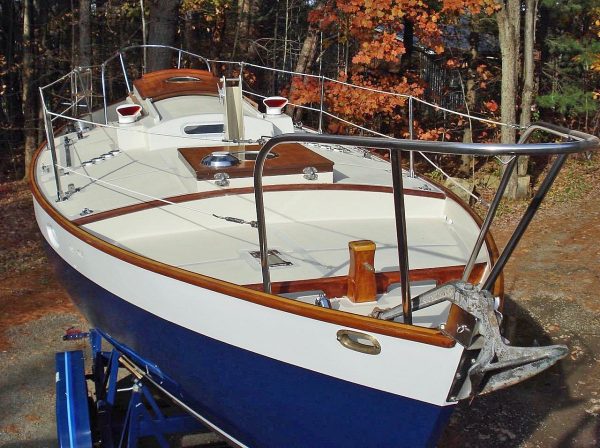
HERE’s NUTCRACKER 46 years after first launched, restored to like-new condition. WEST System cold molded yachts last virtually forever, given a facelift every 50 years or so.
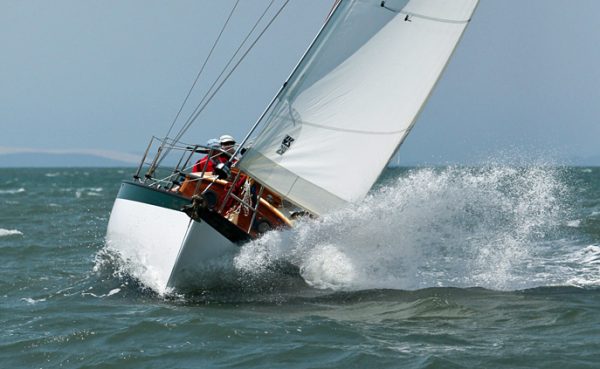
TOM THUMB coming at you. A lot of boat, a lot of ballast, and a lot of wind.
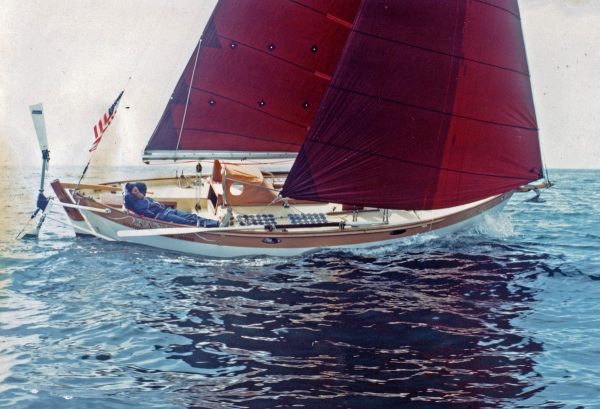
A GUY NAMED DICK CROSS BOUGHT A KITBOAT FROM Tom and hired my brother Art to help him finish it. Art drew a rig with a huge 150% overlap genoa, and in less than ten knots of wind the boat really flew. Like many well-drawn double-enders his boat KARMA could be easily steered by a wind-vane self steerer. Here Dick is having a kip while the boat steers itself happily to windward. Dick was a man’s man. No roller furling on that genoa, and if the breeze got above 10 knots he’d have to wrestle it into submission and hoist a smaller jib. And don’t forget his version had a bowsprit.
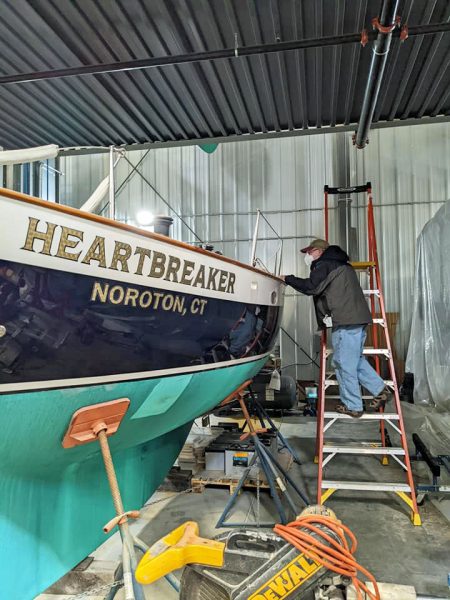
IN 2022 I caught up with hull number one of the FRANCES, built by Tom Morris alongside the hull that I was completing in his shop. She’s still going strong. I still remember that her original owner asked me to design a tall double-spreader rig for her so that she could be raced.
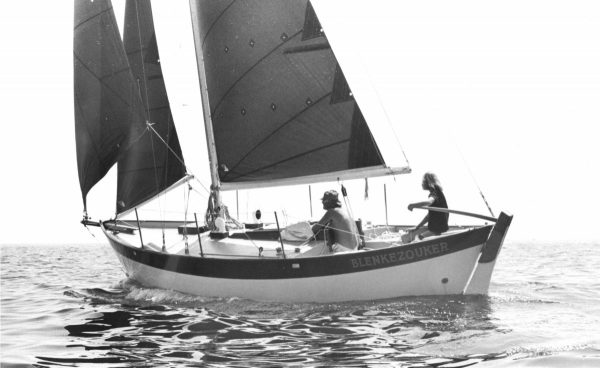
TOM MORRIS sent this photo of one of his first builds, BLENKEZOUKER, to most of the European yachting magazines. As a result Bernard Hayman, the then editor of Yachting World in Britain, wrote an embarrassingly favourable editorial, decrying the fact that it took a bloody Yank to design something so beautiful. Four British boatbuilders saw the editorial and heard that it had in the words of Hayman elicited more inquiries to Yachting World than any article in its history, and asked to build it under license. Tom Morris and I chose a young and ambitious entrepreneur, Peter Gregory, and his new company Victoria Marine, to build the Frances in the UK. In a few years he had built more than 150 Franceses is various versions, and commissioned three more Chuck Paine designs to be built at his shop in Warsash at the mouth of the Hamble river. The success of the Frances and my next design for Peter, the Victoria 30 , caught the eye of Charles Maunder at Bowman Yachts in Woolston (Southampton, UK), and in the next few years he built hundreds of yachts to four of my designs.
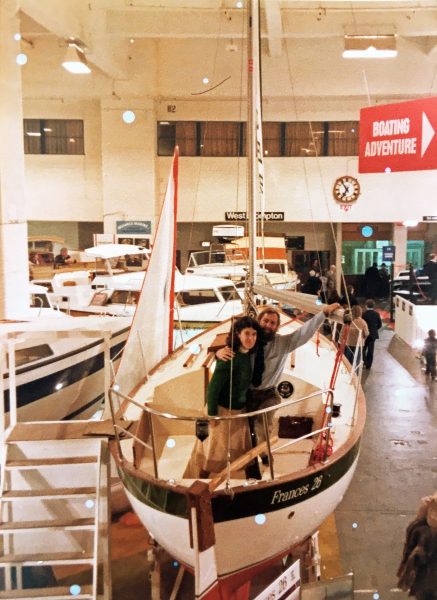
CHUCK AND DEBBY at their first London Boat Show, 1977.
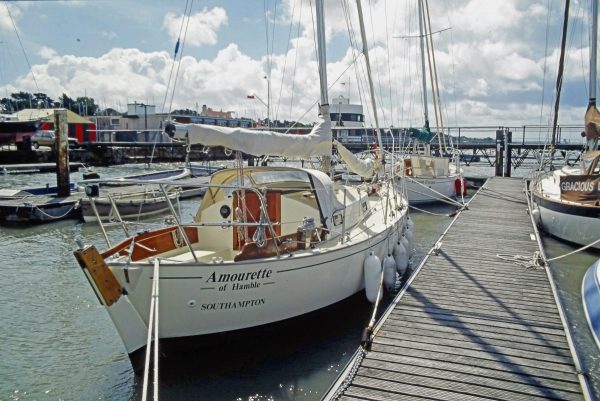
HERE’S ONE OF the many Franceses at her birthplace Stone Pier Yard in Warsash, UK. Not your typical English weather, but when the sun shines in southern England, it’s glorious.
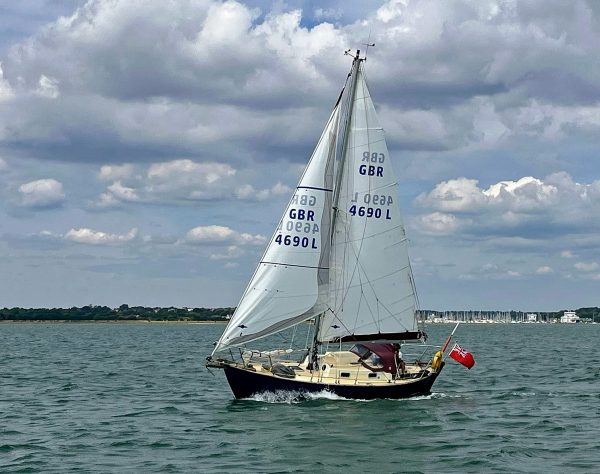
A CUTTER RIGGED Frances somewhere along the coast of England. The wobbly perimeter of the sunshade makes me crazy.
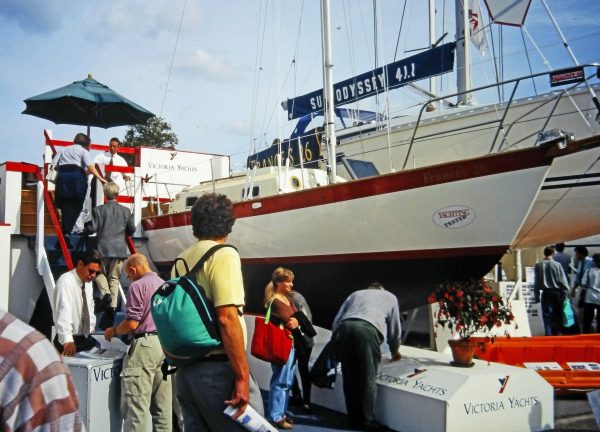
THUS BEGAN MANY YEARS of commuting to England to sell boats, and to convince either Peter or Charles Maunder of Bowman Yachts that he needed a new design. I would attend the London Boat Show at Earls Court Exhibition Centre every January, and the Southampton Boat Show every September. In all those years I can’t recall a Southampton show when the relentless rain that typifies an English summer didn’t cease for the week in September that I had to be at the show
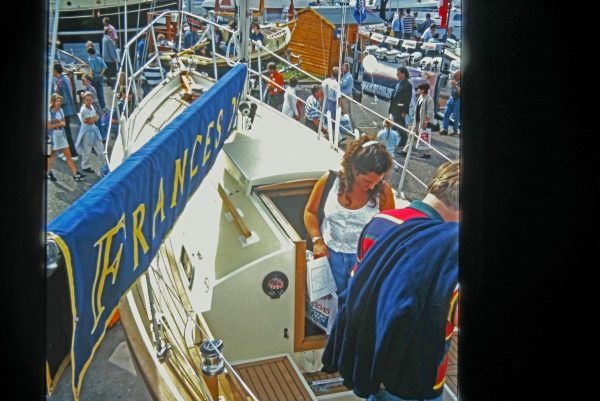
A TYPICAL Southampton Boat Show scene.
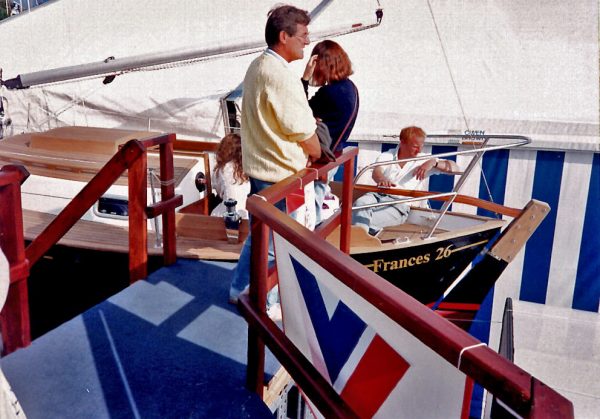
DITTO. Was it my sunny disposition that brought the fine weather?
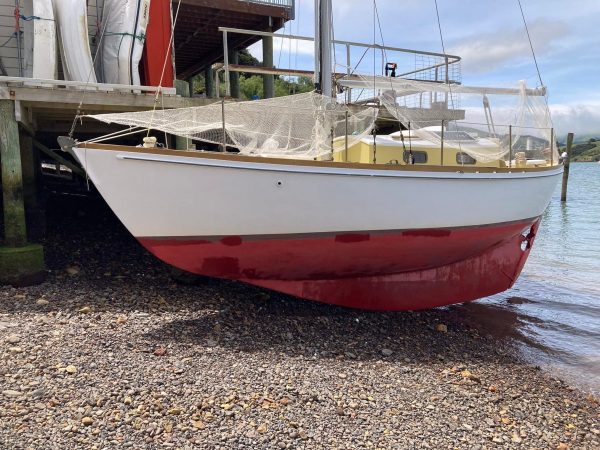
GALAVANT WAS built in New Zealand in wood/epoxy. If you ever get to Christchurch, drive to its seaport Lyttleton and maybe you will find her there.
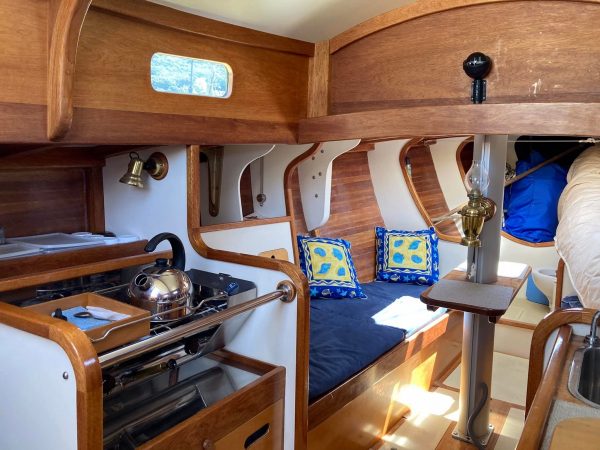
SOME OF THESE home-built boats were really nicely done. GALAVANT ‘s owner decided to open up the interior by eliminating the usual “main bulkhead”, using a series of hanging knees to provide adequate strength. I like it.
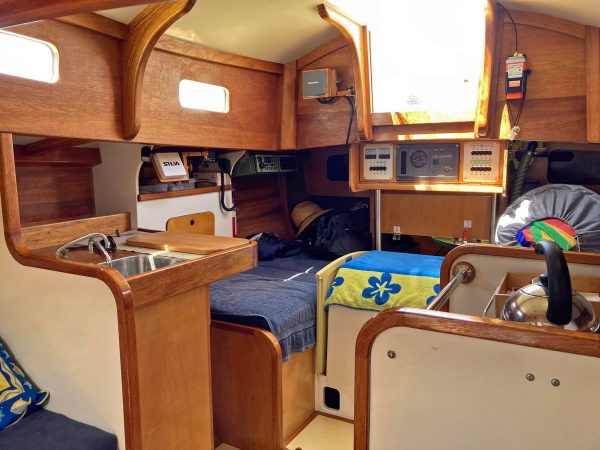
SAME BOAT looking aft
I PARTICULARLY LIKE the cabin sole- nice, light color.
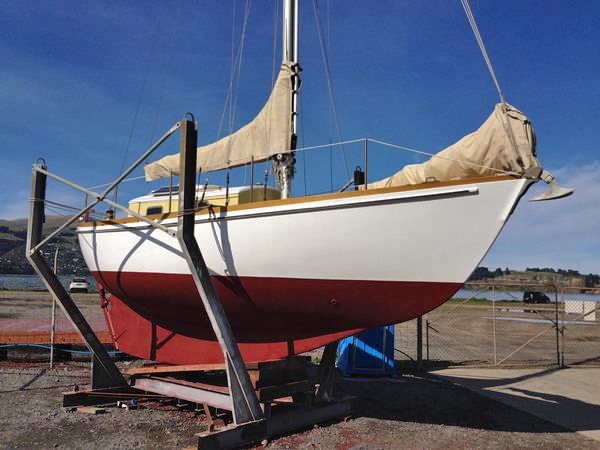
ANOTHER PHOTO OF HER SHAPE.
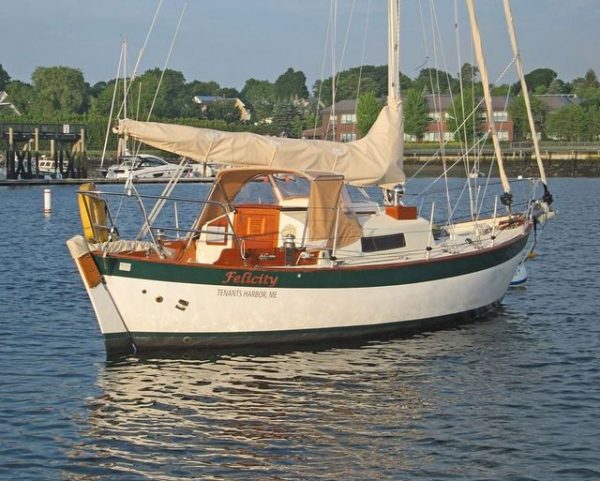
FELICITY . A British Frances that sailed to Maine.
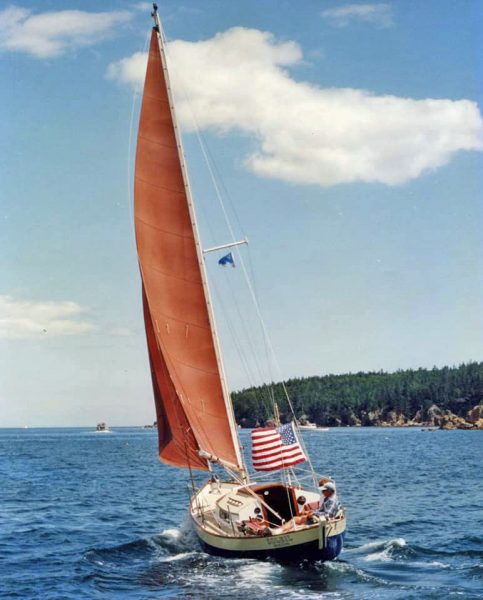
SOLEIL . Tom Morris owned this one himself for awhile.
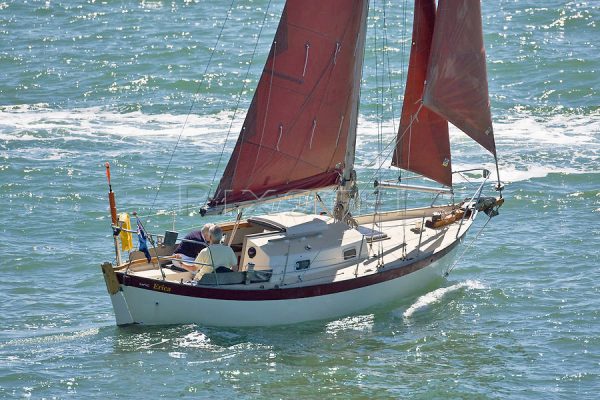
A VICTORIA FRANCES. Location unknown. This is the tidy original “British Cutter” rig. Not fast, but it could stand up to much more wind than the tall, racy rigs.
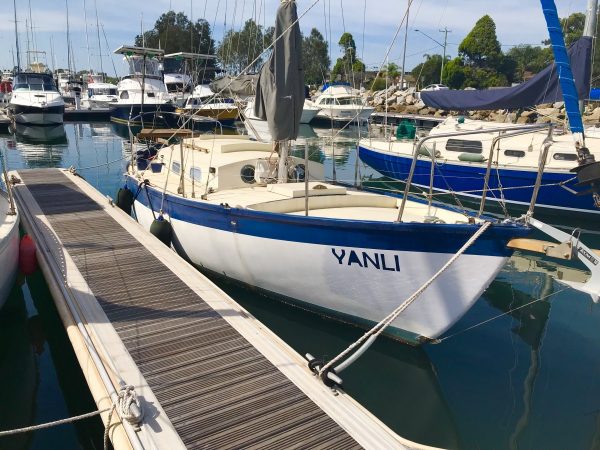
I FOUND YANLI in Bateman’s Bay, Australia. When I encountered her I didn’t know her story. She must have been shipped there on the deck of a freighter, I thought. Nobody would be crazy enough to sail a Frances that distance. Then through the Chuck Paine Yacht Designs Fan Club on Facebook I learned her actual story. A fellow bought her new in Warsash, UK. He financed her. Put down his down payment, hoisted the sails, and that was the last the bank heard from her owner for years. He sailed her south to the Canary Islands, then across to the Caribbean. Then through the Panama Canal. Howcum the bank didn’t have an arrest warrant waiting for her at this obvious choke point I can’t fathom. Then on he sailed to New Zealand. As if that weren’t enough adventure sailing too small a boat on too large an ocean, he then sailed across the Pacific again to the North, to Hawaii. And that is where the bank finally caught up with him. The bank arrested the boat and sold it to an Aussie. Who then sailed it BACK across the Pacific to Australia. Which is how I got to take this photo in Bateman’s Bay Australia three years ago- not looking too bad after the equivalent of sailing around the world!
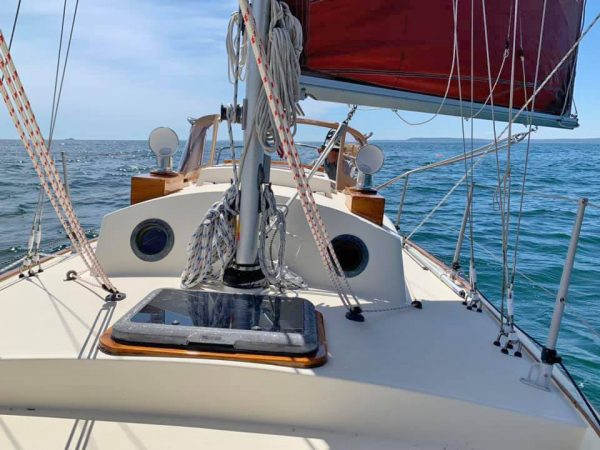
THE JOYS OF downwind sailing.
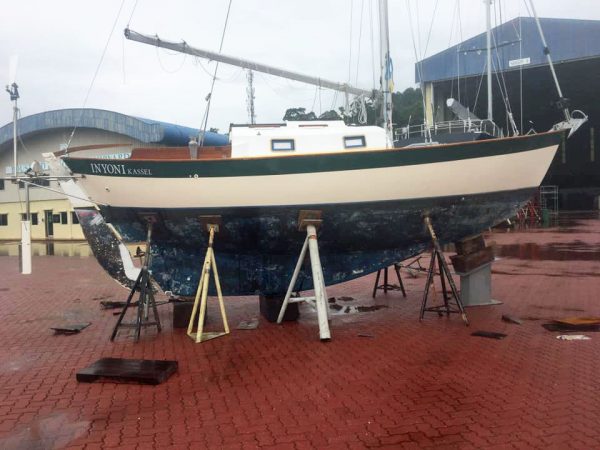
INYONI . Needs some bottom paint.
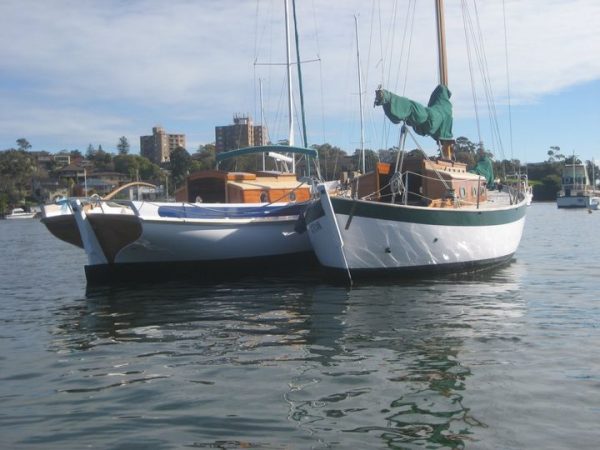
TOM THUMB in Sydney, Australia.
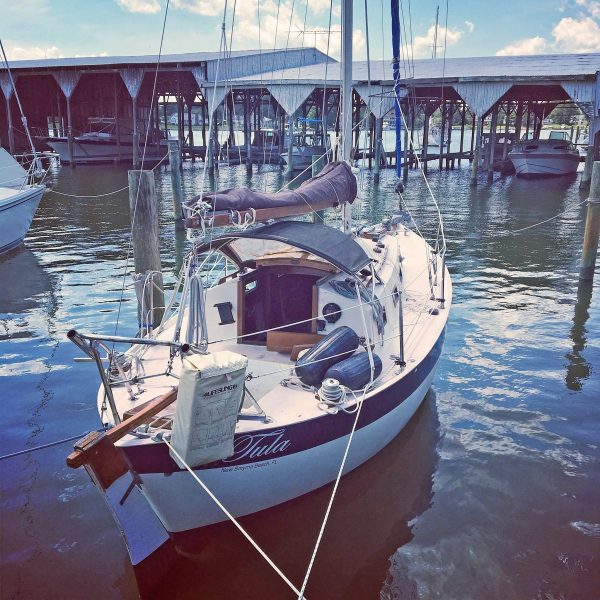
TULA . Someplace in Florida, I think.
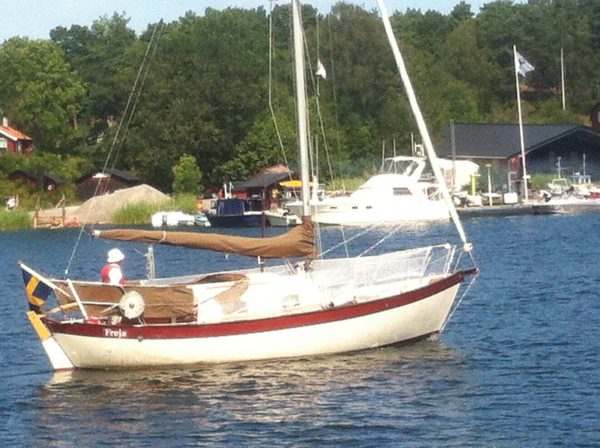
FREJA . Location unknown.
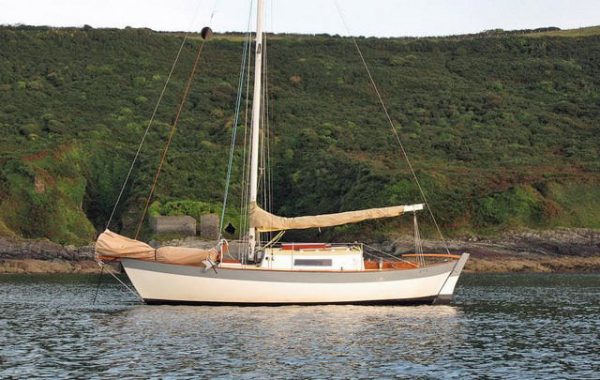
A BRITISH BUILT FRANCES, someplace in England..
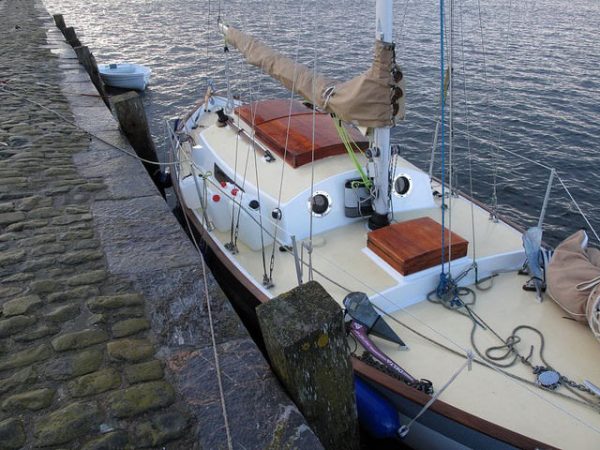
THE CUSTOM VARNISHED companionway and forward hatch are nice touches.
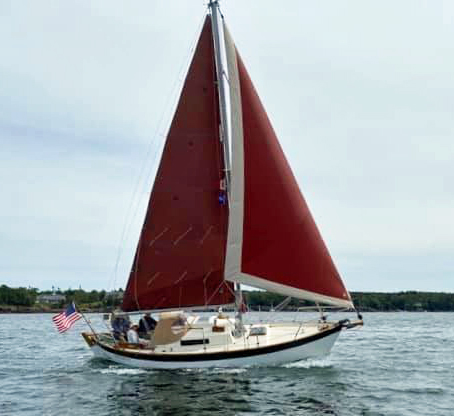
FELICITY SAILED transatlantic from the UK to Maine. She lives in Rockland, Maine now, a few miles from my home.
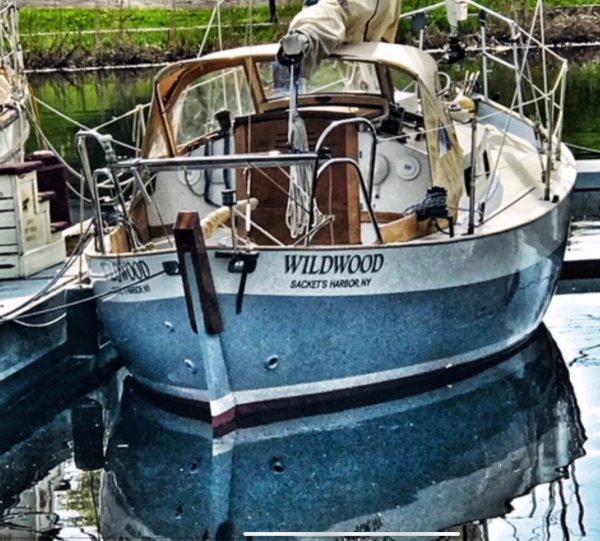
WILDWOOD is one of the Tom Morris built beauties.
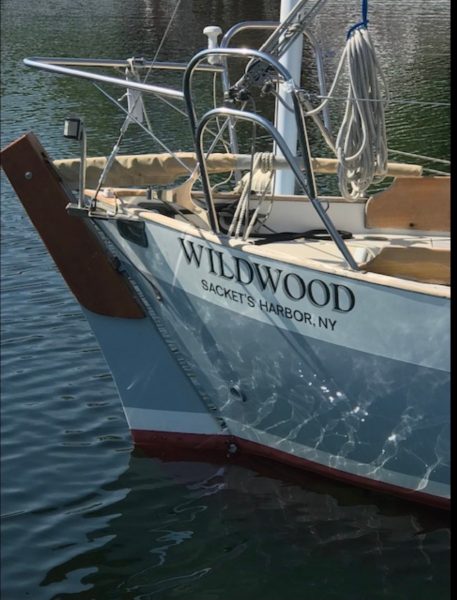
THIS BRITISH BUILT Frances is trying out her new mainsail.
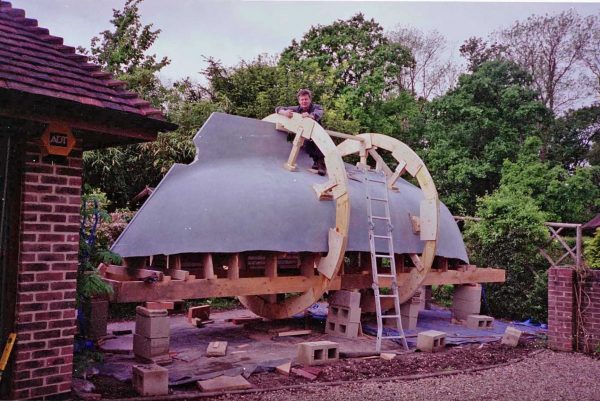
A HOME-BUILT Frances on turnover day. Location and details unknown.
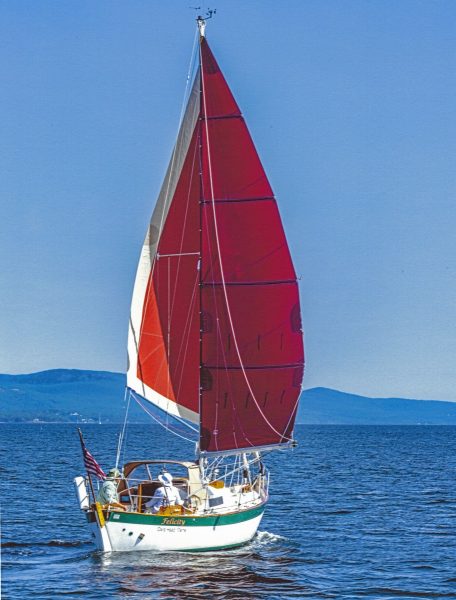
FELICITY wing and wing.
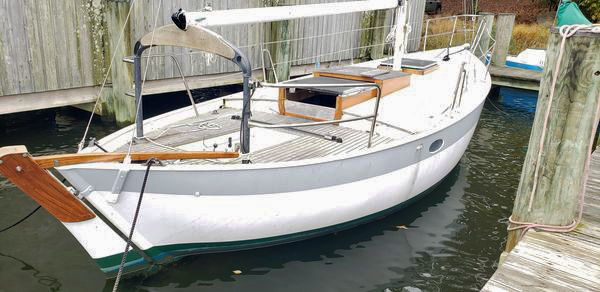
TOLERANCE . In my dotage I’ve come to find varnished teak railcaps intolerable. I really like the ones that are simply painted white. They’re so much easier to take care of. And if the shape of the design is inherently beautiful, varnished teak is just gilding the lily.
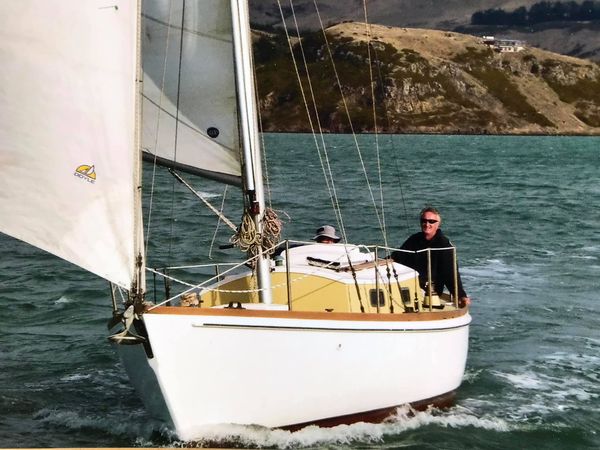
A CLOSEUP OF GALAVANT sailing in Lyttlton Harbour, NZ.
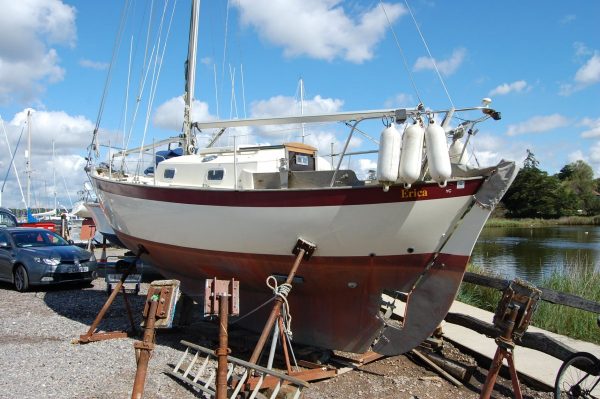
ERICA . I think she’s at Universal Marina on the Hamble river.
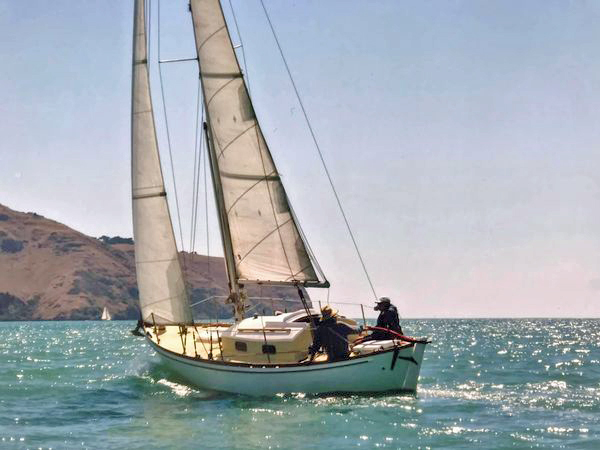
GALAVANT Galavanting nicely to windward.
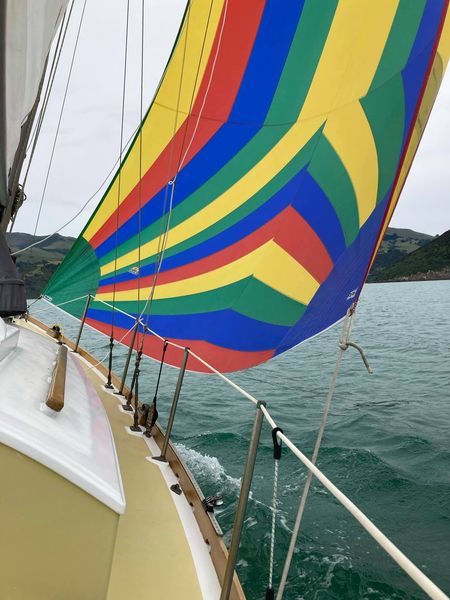
GALAVANT’s colorful reacher.
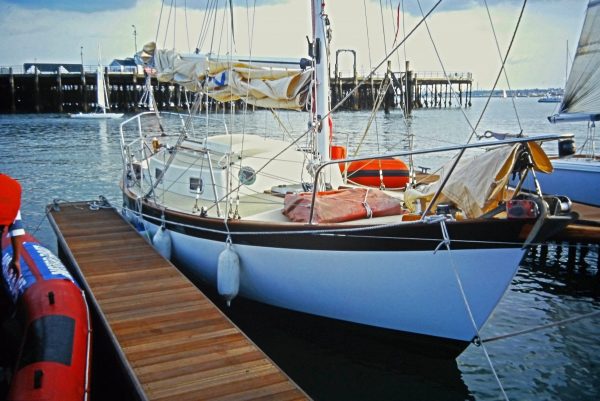
ONE YEAR PETER GREGORY showed one of his creations in the water at the Southampton Boat Show.
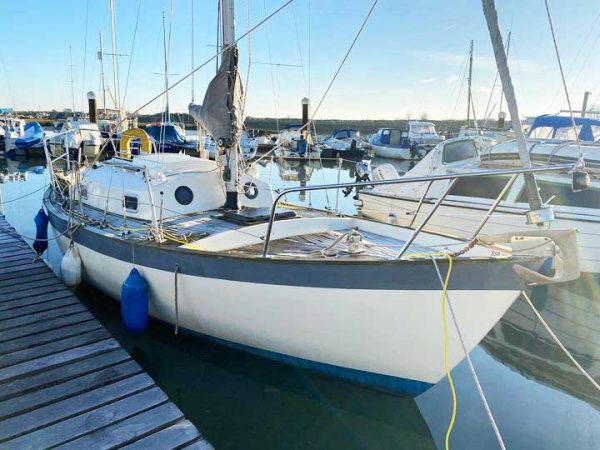
WHIM. Tollesbury, Essex, UK.
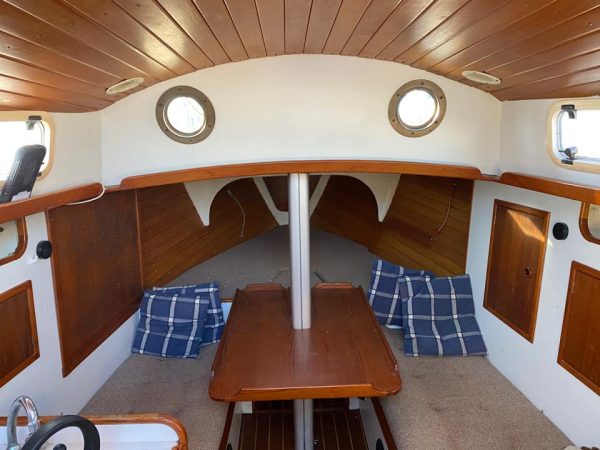
WHIM ‘s nice, wide open interior.
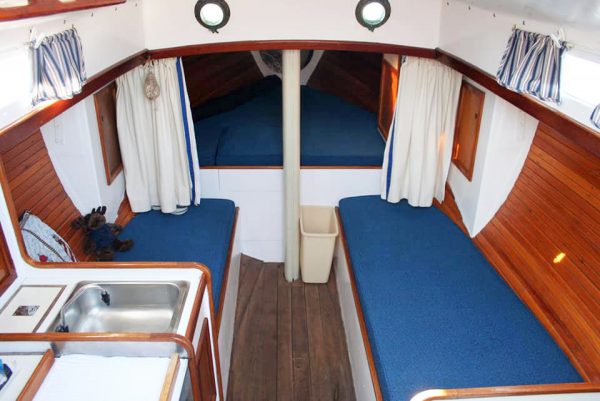
SOLEIL’ s Interior
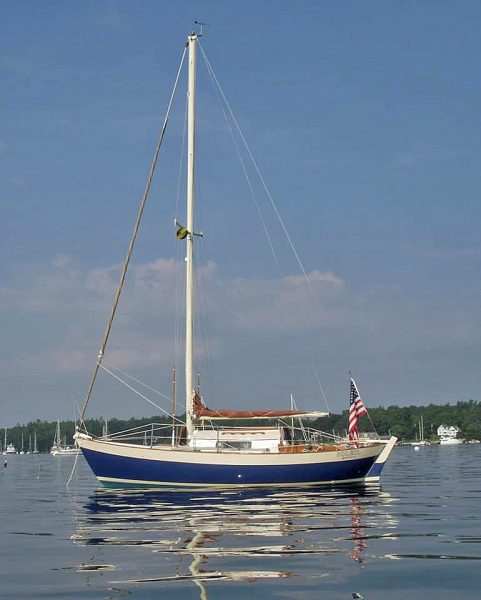
SOLEIL – Morris built Frances
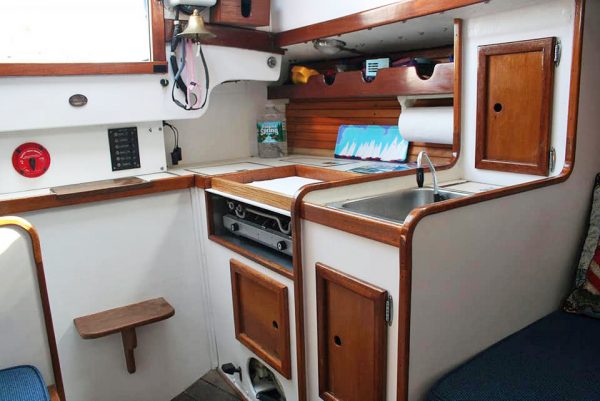
SOLEIL ‘s Galley.
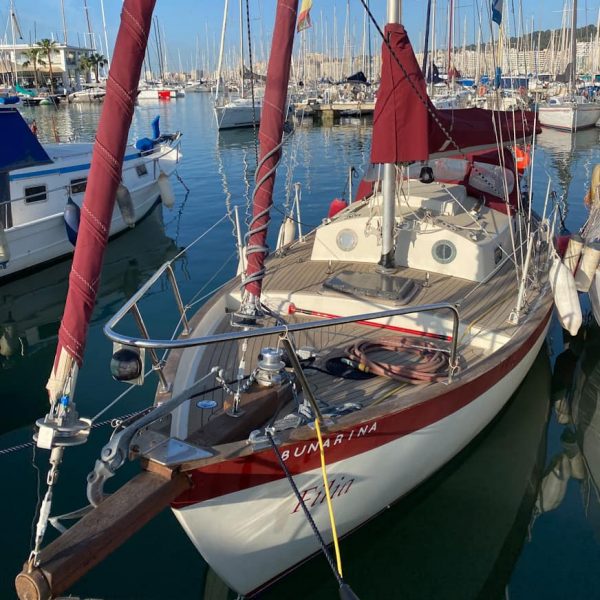
A CUTTER RIGGED FRANCES. Location unknown.
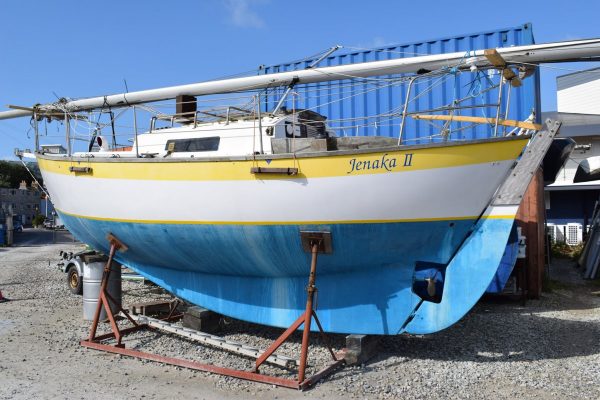
AN ENGLISH FRANCES somewhere in the UK. One reason the Frances sails reasonably well despite the shoal draft is the absence of a garboard radius. The entire keel does its work of preventing leeway- all the way up to where it meets the hull.
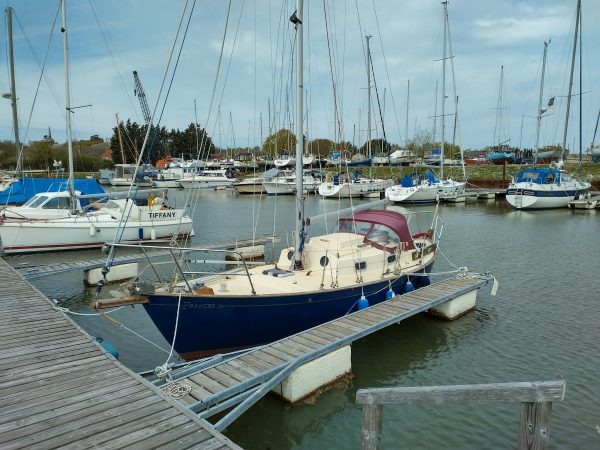
A cutter rigged Frances somewhere in the UK.

ELLA is one of the two FRANCESes I am aware of that fitted a gaff rig.
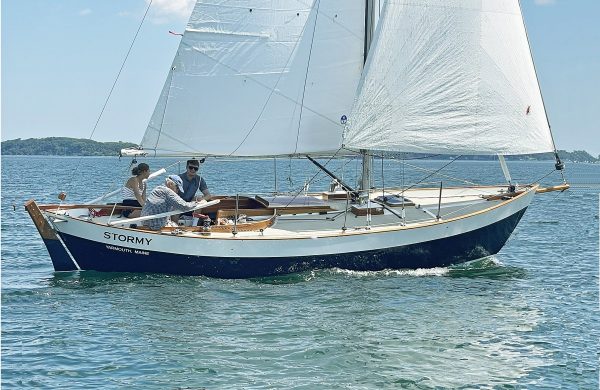
Multi-Hull Power Boat
Multi-hull powerboats are generally referred to as “power catamarans” because most of these designs ride on two h ulls . You may find a power trimaran with three hulls, but they’re rare. Technically, pontoon boats , which are open deck boats built on twin metal flotation tubes are also multi-hull powerboats and pontoon boats with three tubes are called “tri-toons”.
Power cats have become extremely popular in recent years for multiple reasons: they offer more deck and cabin space than a monohull powerboat of the same length, they tend to be more fuel efficient since they don’t drag heavy ballast through the water, they’re very maneuverable since their engines are set wide apart eliminating the need for a bow thruster (a propeller that provides side thrust and therefore maneuvering control), they’re very stable at rest so you can get a good night’s sleep in a rolly anchorage, and often people feel less seasick on multi-hulls because they have a different motion on rough water.
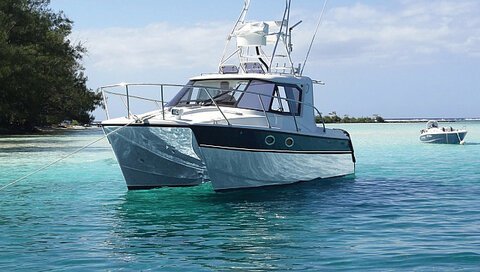
with local dealers to explore models and pricing in your area.
Explore Boat Brands
Multi-Hull Power Boats
- Invincible Boats
- Prestige Yachts
Use our Boat Loan Calculator to get a better idea of your own budget.
Crunch the Numbers
Looking for a different boat?
Try our Boat Finder
Activities with Multi-Hull Powerboats
GREAT FOR Saltwater Fishing • Day Cruising
What you do with a power cat will depend on the brand, size and design of the vessel. Smaller center console cats with an open deck and a steering station in the middle may be perfect for fishing or diving and since they don’t roll, they induce less fatigue throughout the day.
Larger power cats may be designed to coastal cruise or cross oceans so they’ll have a galley (kitchen), multiple heads (bathrooms) and usually three to four sleeping cabins typically found in the deep hulls. Because power cats are large, stable platforms, they’re an excellent choice for families with small children or older, less mobile passengers.
Pontoon boats have gained market share recently due to their increasingly better construction and an added tube that makes them more buoyant. They can carry larger engines that make them faster and able to engage in towing sports like wakeboarding and water skiing. Pontoon boats are usually used for family lake boating and entertaining. Their small metal hulls or tubes cannot be accessed like those on cruising power cats.
Ownership Costs of Multi-Hull Powerboats
The size, age, brand, overall design and onboard equipment will dictate the purchase price of a multi-hull powerboat. In addition to the initial price, you’ll need to estimate the cost of outfitting like electronics that are often priced separately. Our Boat Loan Calculator can help you see if the costs of ownership fall within your budget.
Where multi-hulls can get expensive is dockage since many larger models won’t fit into a standard width slip and will require an end tie (usually found at the end of a dock or bulkhead ). These spaces are limited in supply and therefore more costly. Smaller fishing cats and pontoon boats may add the cost of a trailer (but that in turn, may save on dockage fees). Ship’s registration with your state authority or documentation from the U.S. Coast Guard will also add a small fee.
Normal maintenance for all boats includes interior and exterior cleaning, bottom scraping, hull polishing and waxing, and so on. Keep in mind that you’ll be paying these services for basically two boats since there are two hulls. Most larger power cats have redundant systems ( bilge pumps, fresh water pumps, battery banks, engines, etc.) and that provides a backup system if one fails. However, with more equipment comes more general maintenance time as well as repair cost.
Power cats need fuel although their engines are often smaller and therefore cheaper to feed. If the boat is large enough to require paid crew, that will add to the cost of operation as well.
Multi-Hull Power Boat Technology/Materials/Features
Due to advances in construction techniques, today’s multi-hull powerboats are lighter but stronger so they can carry more and go faster and they’ll age better than their predecessors. Large cruising cats will have generators to charge batteries, sophisticated navigation and communications electronics, full galleys, watermakers (desalination equipment) electric toilets and many other comforts of home, which make them ideal for extended cruising.
Explore Similar Boat Types
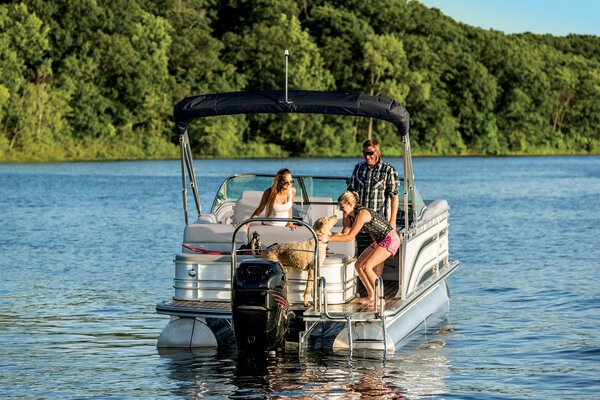
Pontoon Boat
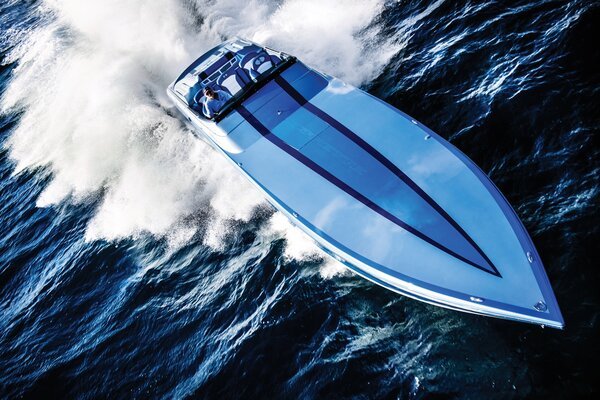
High Performance Boat
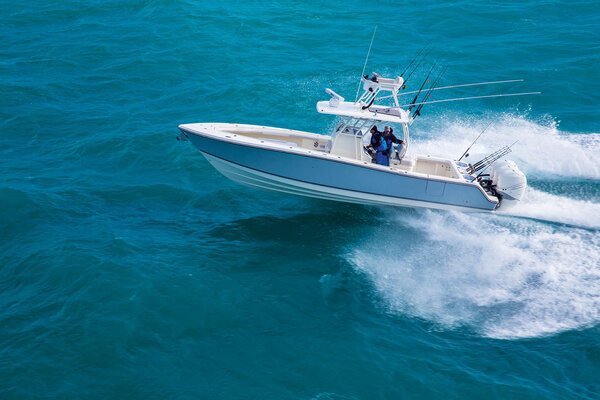
Center Console
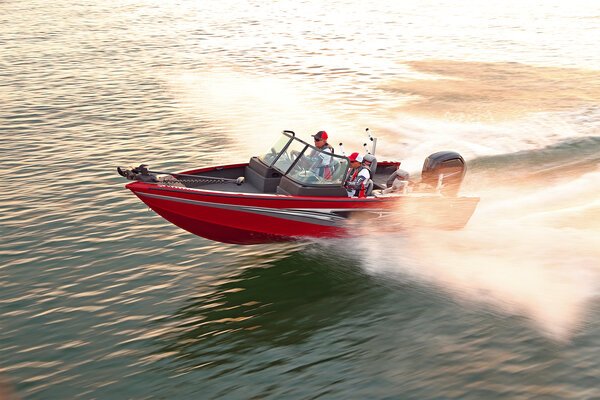
All-Purpose Fishing Boat
Join Our Newsletter!
Get community news, buying bargains, and how-to guides at your fingertips.

Hokulea: History of Hawaii’s Voyaging Canoe
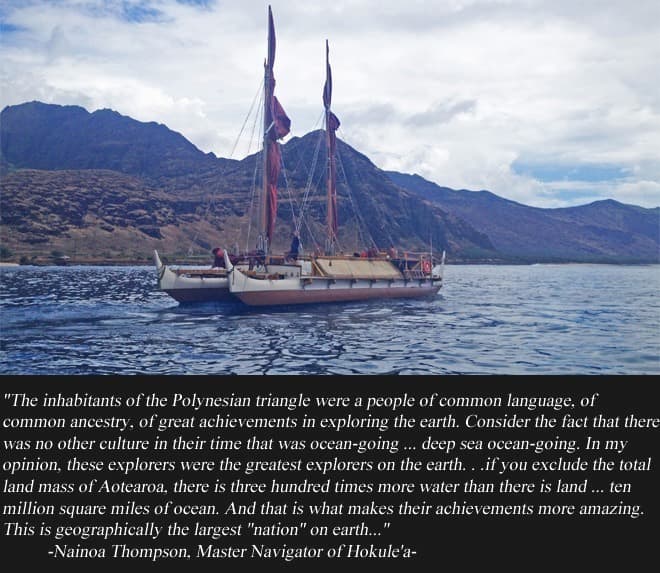
As Nainoa Thompson so eloquently stated, there was once a time when the Polynesians were the most skilled navigators on Earth.
Only 50 years ago, however, during the 1960’s, the act of Polynesian voyaging and wayfinding had been reduced to memories and lore.

There were no canoes which endured deep water sails, there were no captains who could read the map that is etched in the sun and stars, and there was no breath in the maritime spirit which one connected Polynesia.
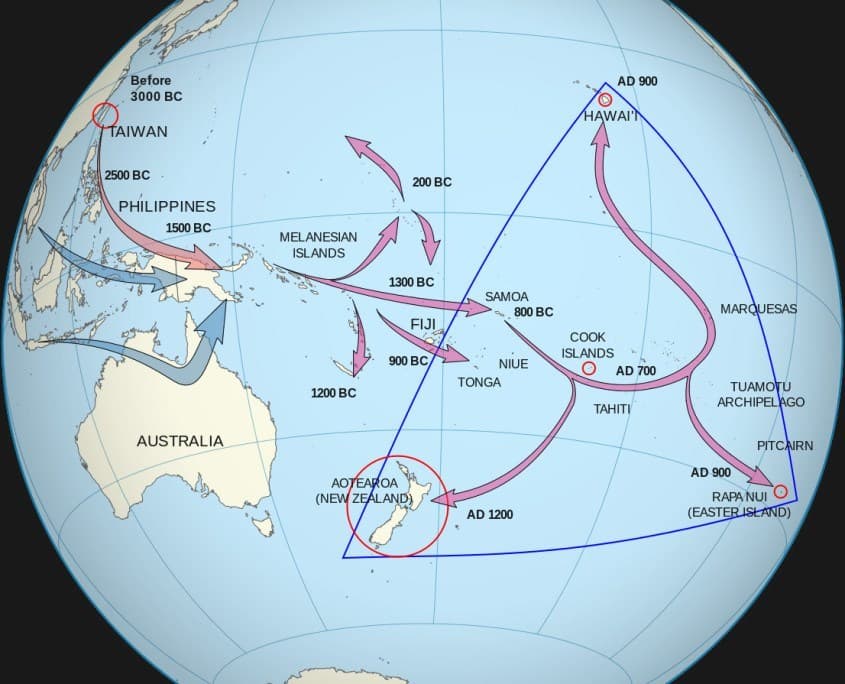
Looking at the movement of peoples in the Pacific, the first Hawaiians were voyaging Marquesans who arrived around 400 AD. The Tahitians would arrive to supplant the Marquesans around 900 AD, and while voyages between Tahiti and the Hawaiian Islands may have existed for a short period of time, the maritime connection was eventually severed and the two nations drifted apart.
To Herb Kane, an Oahu based artist and avid paddler with an interest in Polynesian voyaging, this was an unacceptable loss of culture which couldn’t be allowed to continue. Specifically, Kane had a vision of a double-hulled sailing canoe that would voyage from Hawaii to Tahiti, and reignite the unifying spark between the people of Polynesia.
More than just a traditional canoe, however, the voyage would employ the ancient techniques of navigating, route-planning, and wayfinding. Though Kane was confident he could silent the critics, there was the fundamental problem that there was no one in Hawaii who still knew the ancient techniques.

From a voyaging perspective, when you see Hokule`a arc overhead, you know you’re sharing the same latitude with the Main Hawaiian Islands, and it’s a shining light in the night time heavens which helps to point the way home.

After its journey through the Hawaiian Islands, Hokule‘a experienced a groundswell of support for her upcoming voyage to Tahiti. Crew were chosen from various islands, and in 1976, along with cultural anthropologists and the master navigator Mau, Hokule‘a departed for a 2,500 mile journey without a compass or maps; this would be the first time in over 600 years that a voyaging canoe using traditional techniques would connect the Polynesian chains.
Through it all, the crew was constantly fascinated and amazed at Mau’s depth of wayfinding knowledge, and as crewmember Shorty Bertelmann put it, being around Mau and being able to glean his knowledge “was like a living ancestor that you could finally talk to. “
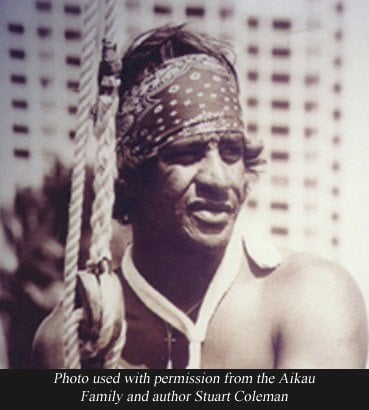
For as much jubilation surrounded the voyage, tragedy unfortunately lay right around the corner.
Having returned to Hawaii in 1976, another voyage was planned for 1978 between the Hawaiian Islands and Tahiti. As with the first voyage, modern conveniences were left behind in lieu of traditional methods, and on the first day of the sail, just 12 miles south of Moloka‘i, Hokule‘a was battered by gale force winds and capsized in the growing seas. Clinging to the hulls of the damaged canoe, the crew of Hokule‘a spent an uncomfortable evening adrift in the open blue.

Today, Eddie is lauded for his courage and sacrifice in the face of devastating circumstance, and the full story of Eddie Aikau is masterfully chronicled in the classic biography, “ Eddie Would Go ,” by Stuart Coleman.
Today Hokule‘a continues to ply the Pacific and her trips have given rise to a culture of voyaging. Her sail to New Zealand inspired Maori leaders to revive the art of canoe building, and she has sailed the Pacific from Japan to Micronesia and the west coast of the Mainland U.S.
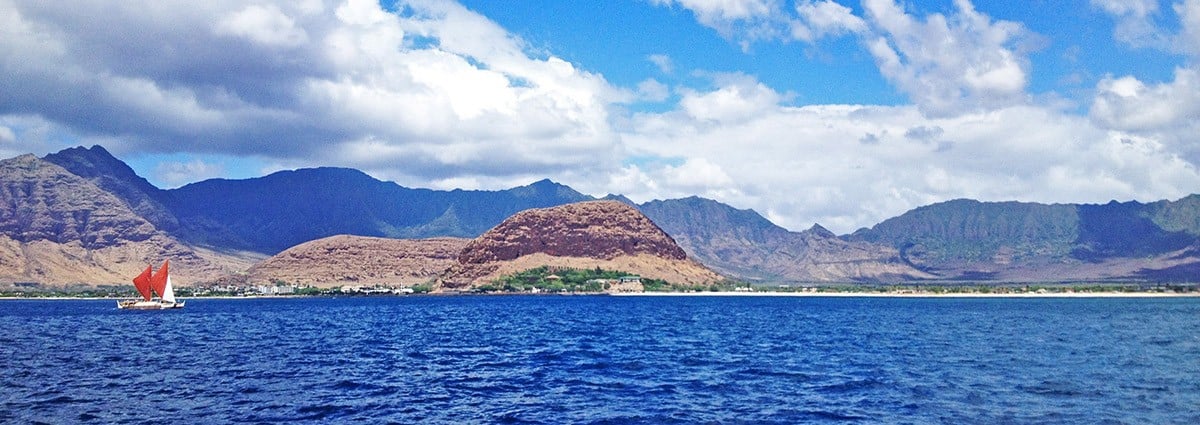
In the summer of 2014—38 years after her launch—Hokule‘a embarked on a round the world voyage to 26 countries. The voyage was entitled “Malama Honua,” which translates “to care for our Earth,” and the sail aimed to raise awareness for a peaceful and sustainable future.
Three years after sailing nearly 40,000 nautical miles around the world, the Polynesian Voyaging Society and its crewmembers returned from the Malama Honua Worldwide Voyage. An arrival ceremony and homecoming celebration took place on June 17, 2017 on Oahu’s Magic Island, with tens of thousands of people awaiting Hokule‘a’s historic return. A grand wa‘a (canoe) procession, an ancient Hawaiian spear throwing ceremony not seen in 200 years, ‘awa ceremony, hula kahiko, and musical performances were all part of the day’s celebrations.
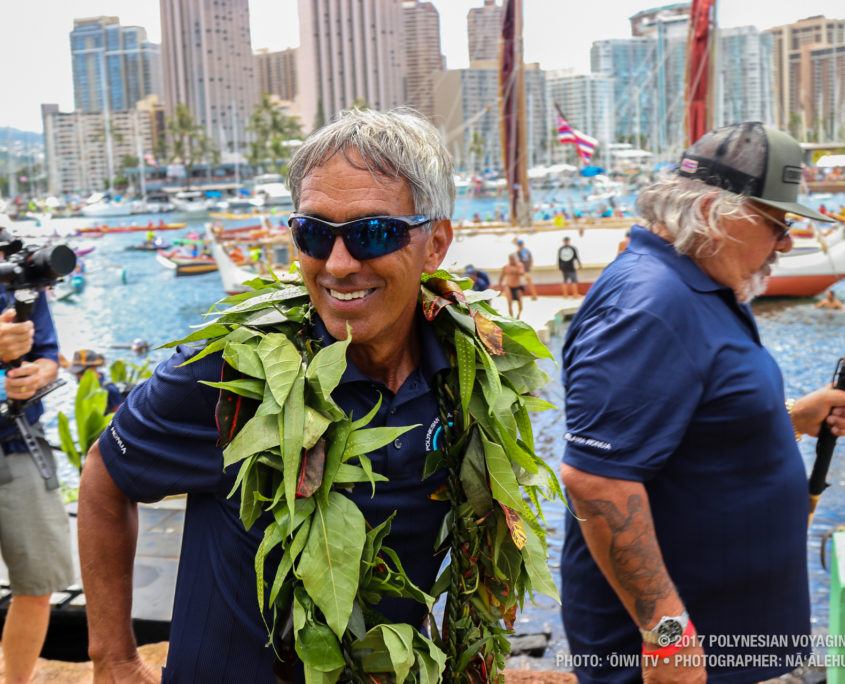
Nainoa Thompson at the historic homecoming celebration of Hokule‘a on June 17, 2017.
As Nainoa Thompson, master navigator and president of the Polynesian Voyaging Society, puts it, “these influences that we want to change and recreate for a new civil kind of society, a more healthy society, will take the work of many…when I look at all the efforts combined, I think therein lies the answer to a healthy and safe future.”
Have you had an experience with Hokule‘a during her voyages around the world? Share it with us in the comments below!
What are we forgetting?
Similar articles, top 10 pics: hokulea at olowalu, top 20 pics: hokulea at honolua, hawaiian paddle sports.
All photos and videos on this website were taken while viewing animals from a responsible distance. Images depicting dolphins or whales in close proximity to people were taken when the animals approached the vessel, and no attempt was made to approach or otherwise disrupt these animals.


COMMENTS
These sailboats have a minimum total sail area of 624 square feet, a maximum total sail area of 3,630 square feet and an average of 968 square feet. Boat Trader currently has 199 multi-hull sailboats for sale, including 76 new vessels and 123 used and custom yachts listed by both individual owners and professional boat dealers mainly in United ...
Ideal for these Multi-Hull boats vary in length from 24ft to 78ft and can carry 4 to 67 passengers. There are a wide range of Multi-Hull boats for sale from popular brands like Fountaine Pajot, Lagoon and Corsair with 304 new and 1,094 used and an average price of $539,011 with boats ranging from as little as $25,530 and $3,793,725. View a wide ...
The Polynesian double canoe is another twin-hulled sailboat. The Polynesian double canoe is another type of boat that originated in the Pacific Islands and is still used today. It is a large canoe that consists of two hulls connected by a platform or deck. The two hulls are typically of equal size, and the deck is usually made of wood or other ...
The amas of the 43 are too small for accommodation, so this boat has a largely open-plan layout, although the owner's cabin is in a separate area to starboard on the bridge deck. There's also a double berth to port that would make an ideal den area for kids, plus a further small double cabin forward at a lower level in the main hull.
Sailing this Outremer 52 for 200 miles over two days and nights! ... such as the forward cabins in the main hull not quite so well. Horizon and rig sightlines and some finishing also leaves room ...
The Best Catamarans for Sailing Around the World A catamaran is a double-hulled boat with a deck or cabin area in between (bluewater cat definition in this article).The double hull design means that the boat rocks less, sits higher on the water, uses less fuel to sail, and can be sailed in shallower waters than a single-hulled boat without worrying about grounding.
Unlike a single-hulled vessel, an outrigger or double-hull vessel generates stability as a result of the distance between its hulls rather than due to the shape of each individual hull. As such, the hulls of outrigger or double-hull boats are typically longer, narrower and more hydrodynamically efficient than those of single-hull vessels ...
WITH THE SHORT, almost 6-foot headroom house, the interior of a Frances could feel much larger than you'd expect on a 26-foot boat. This is a custom WEST-system boat built in New Zealand. The Aft Head arrangement for the Frances with one seaberth and a permanent double.
Single hull, Double bottom, and Double hull ship cross sections. Green lines are watertight; black structure is not watertight. A double hull is a ship hull design and construction method where the bottom and sides of the ship have two complete layers of watertight hull surface: one outer layer forming the normal hull of the ship, and a second inner hull which is some distance inboard ...
View a wide selection of multi-hull boats for sale in your area, explore detailed information & find your next boat on boats.com. #everythingboats Canada CA. United States Australia ... Save This Boat. Seawind 1260 . Nelson Bay, New South Wales, Australia. 2023. $851,335 Private Seller. 54. Save This Boat. Lagoon 46 . Marigot, Saint Martin ...
A Formula 16 beachable catamaran Powered catamaran passenger ferry at Salem, Massachusetts, United States. A catamaran (/ ˌ k æ t ə m ə ˈ r æ n /) (informally, a "cat") is a watercraft with two parallel hulls of equal size. The distance between a catamaran's hulls imparts resistance to rolling and overturning. Catamarans typically have less hull volume, smaller displacement, and ...
The double bottom is typically made up of two separate layers: the inner bottom and the outer bottom. The inner bottom is the lowermost part of the ship's hull, directly above the keel, while the outer bottom is located above the inner bottom.. These two layers are usually separated by a space called a ballast tank, which is used to adjust the ship's weight and trim.
Twin Vee boats for sale on Boat Trader are offered at a range of prices, valued from $20,442 on the lower-end all the way up to $806,858 for the more sophisticated yachts. Higher performance models now listed are rigged with motors up to 1,600 horsepower, while shorter, more affordable more functional models may have as low as 146 horsepower ...
The boat can be sailed entirely from the twin helms aft or from the optional interior steering position. ... two single berths, or a double berth. LOA 50'7" LWL 45'4" Beam 15'11" Draft 7'1" Air Draft 79 ... and the hull and deck are a vinylester infusion with carbon reinforcements. The structure of the hull is a single component ...
And a look at the 23CC will prove it. Though the name Carolina Cat may not yet be familiar, don't worry - the builders have plenty of experience with twin-hulled power catamarans. First, simply consider the size of this boat, the power it requires, and the performance it gets. At 22'7" long and 8'6" wide, you can enjoy expansive deck ...
The relationship between monohulls & multihulls. A multihull is a boat or ship with more than one hull, whereas a vessel with a single hull is a monohull.The most common multihulls are catamarans (with two hulls), and trimarans (with three hulls). There are other types, with four or more hulls, but such examples are very rare and tend to be specialised for particular functions.
E ho'okele kakou! Come experience Kamoauli, a traditional Polynesian wa'a kaulua - an all-wood, double-hulled sailing canoe! Kamoauli is dedicated to preserving and perpetuating Hawaiian culture by offering a unique educational platform to share ka moʻōlelo o ka 'āina - the native history, myths, legends and stories of Hawaiʻi. We offer a culturally immersive travel experience at sea along ...
Trailerable. Multi-hull powerboats are generally referred to as "power catamarans" because most of these designs ride on two h ulls. You may find a power trimaran with three hulls, but they're rare. Technically, pontoon boats, which are open deck boats built on twin metal flotation tubes are also multi-hull powerboats and pontoon boats ...
Specifically, Kane had a vision of a double-hulled sailing canoe that would voyage from Hawaii to Tahiti, and reignite the unifying spark between the people of Polynesia. More than just a traditional canoe, however, the voyage would employ the ancient techniques of navigating, route-planning, and wayfinding. ... Three years after sailing nearly ...
Boat hulls — the actual bodies of boats — provide flotation and are usually in contact with the water. Boats come in two broad categories: Monohull — Most boats have a single hull with a pointed bow and a flat transom stern. The bottom of a monohull may be flat, round, or V-shaped. Multihull — These boats have two or more hulls joined ...
C ome experience Kamoauli, a traditional Polynesian all-wood, double-hulled sailing canoe!The crew of this sailing vessel is dedicated to preserving and sharing Hawaiian culture and legends by offering a unique educational platform to share ka mo'olelo o ka 'aina - the native history, myths, legends, and stories of this land - while sailing the waters of O'ahu.